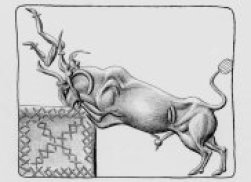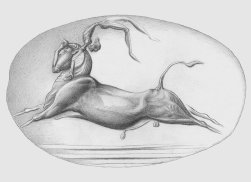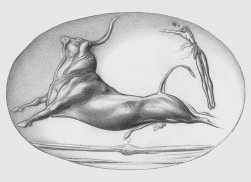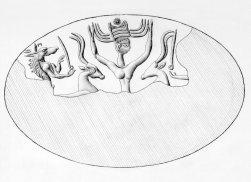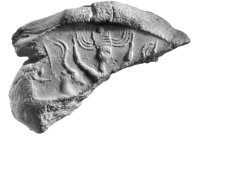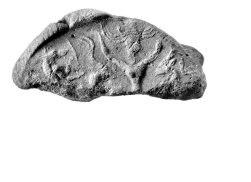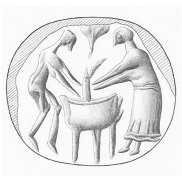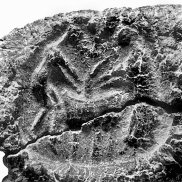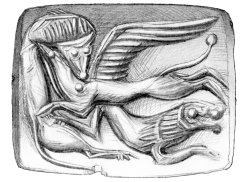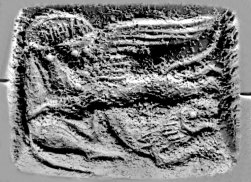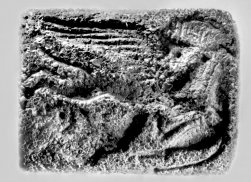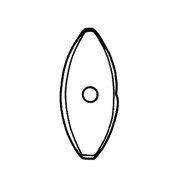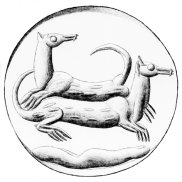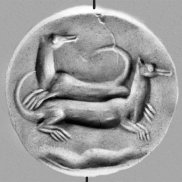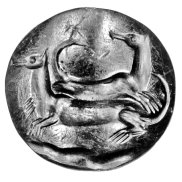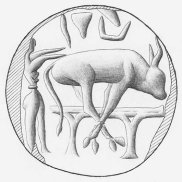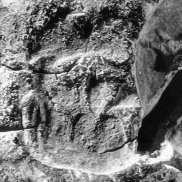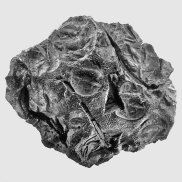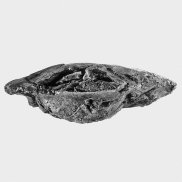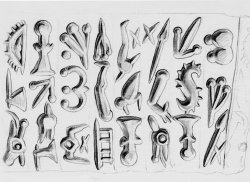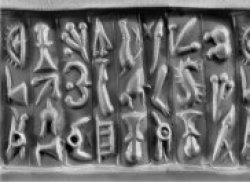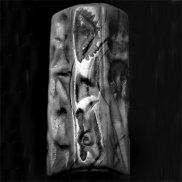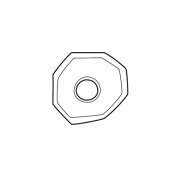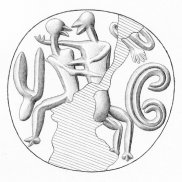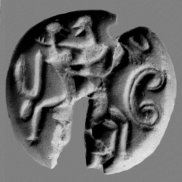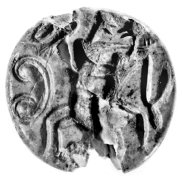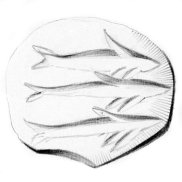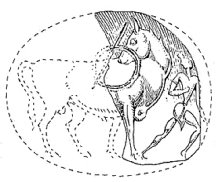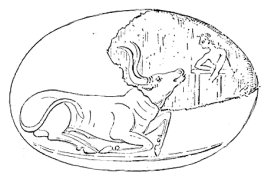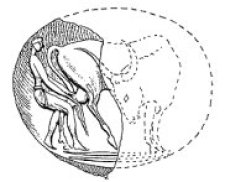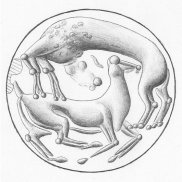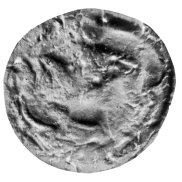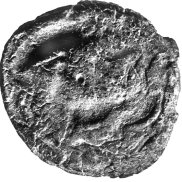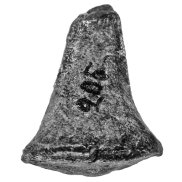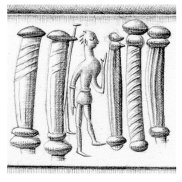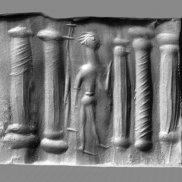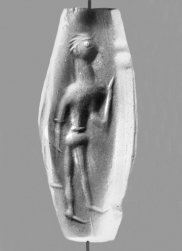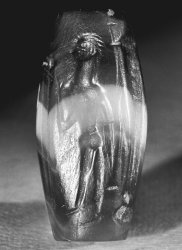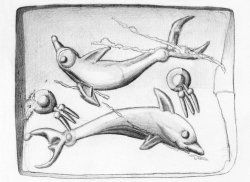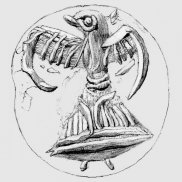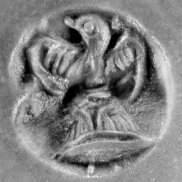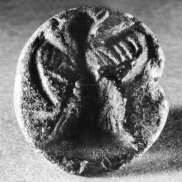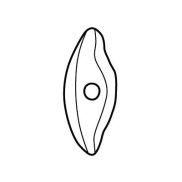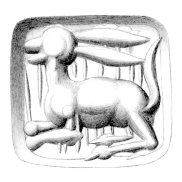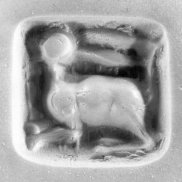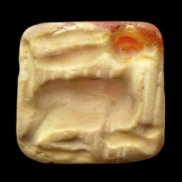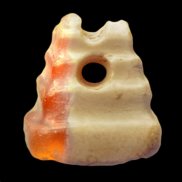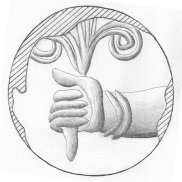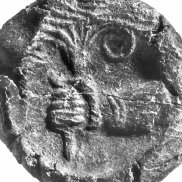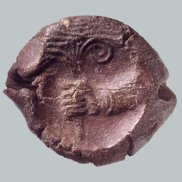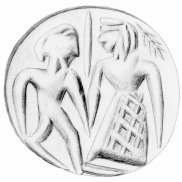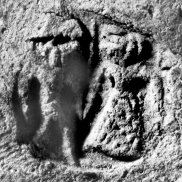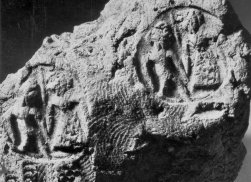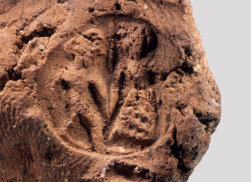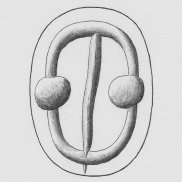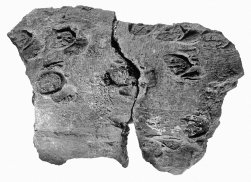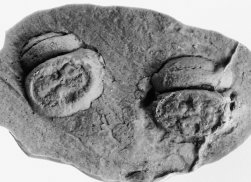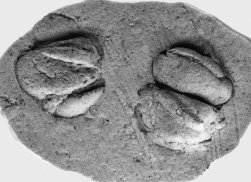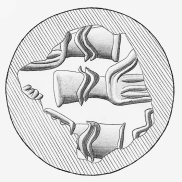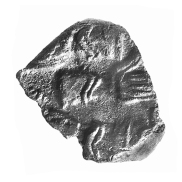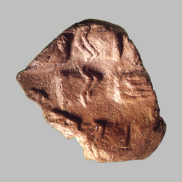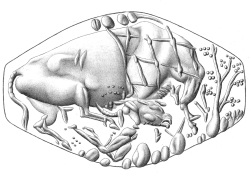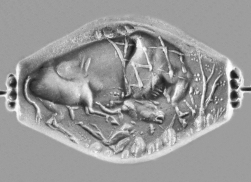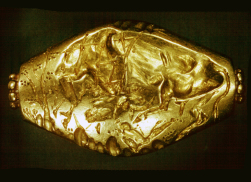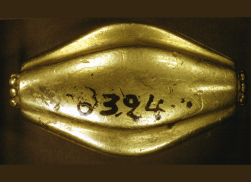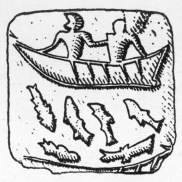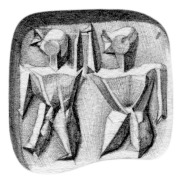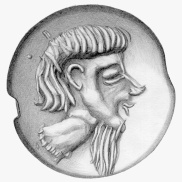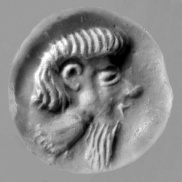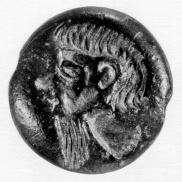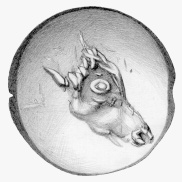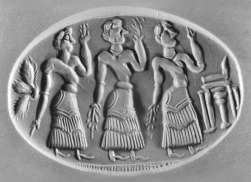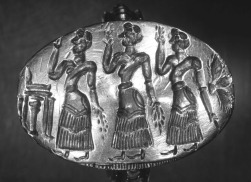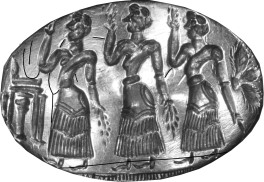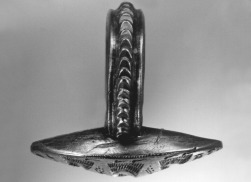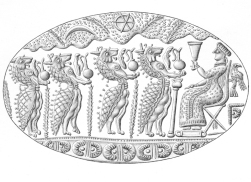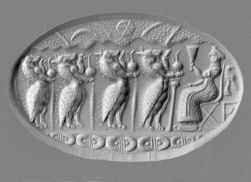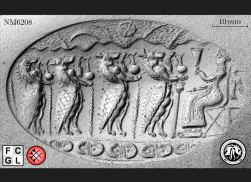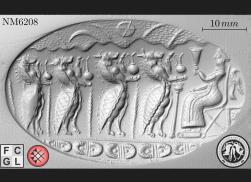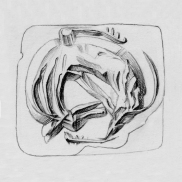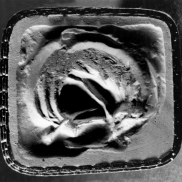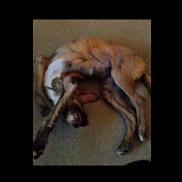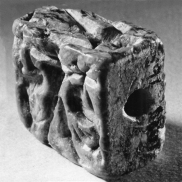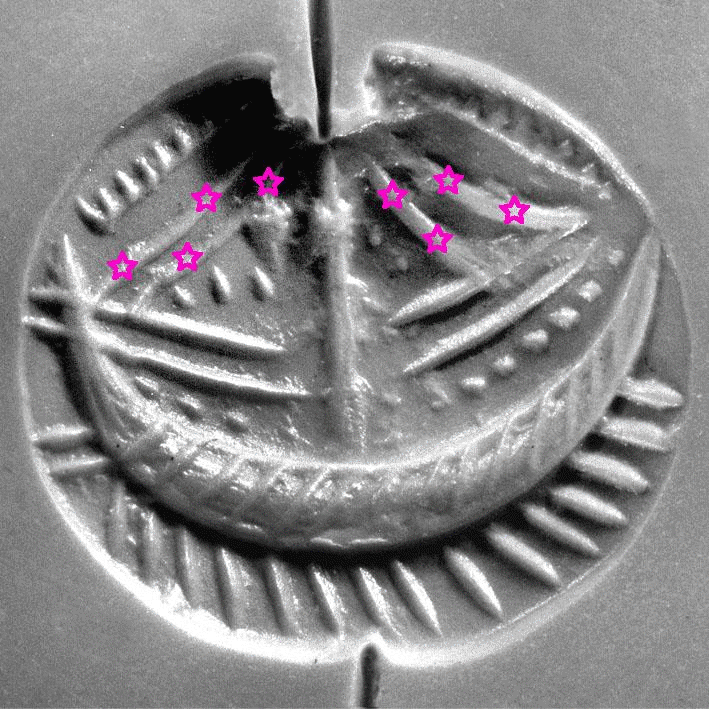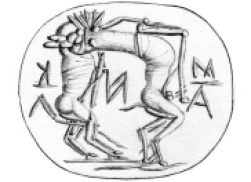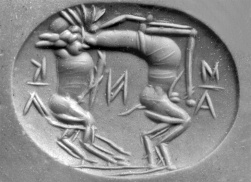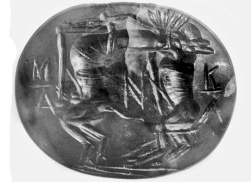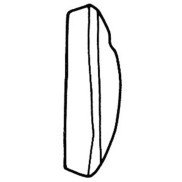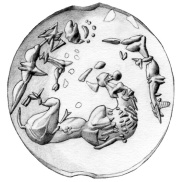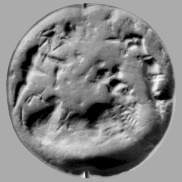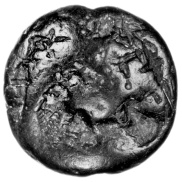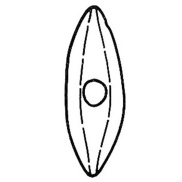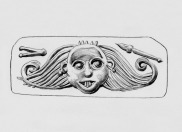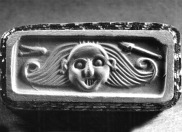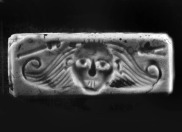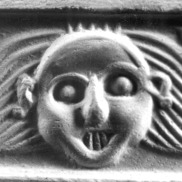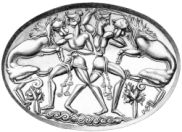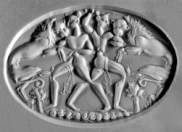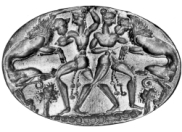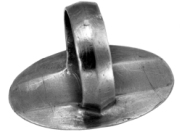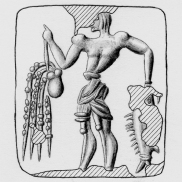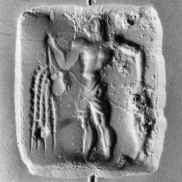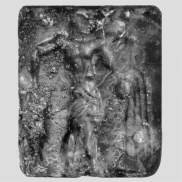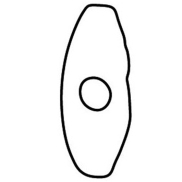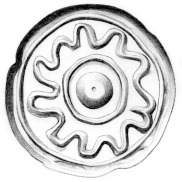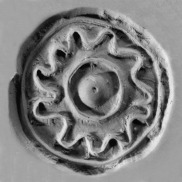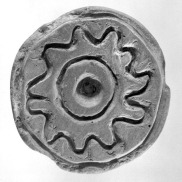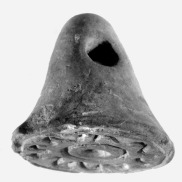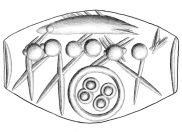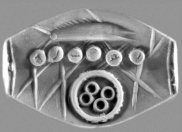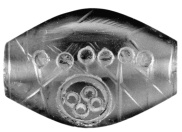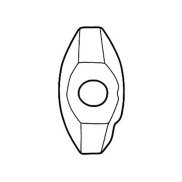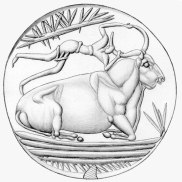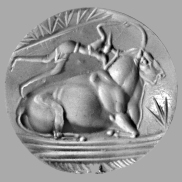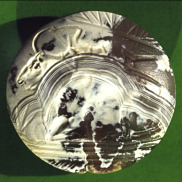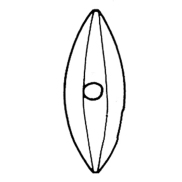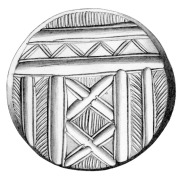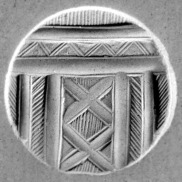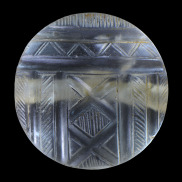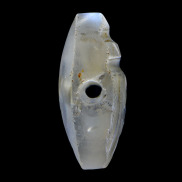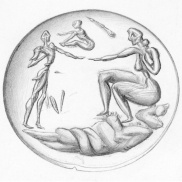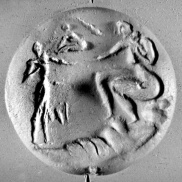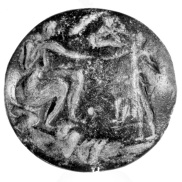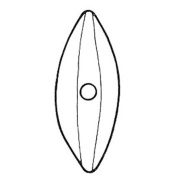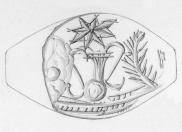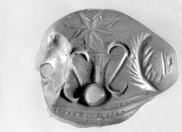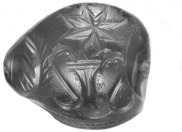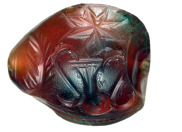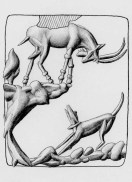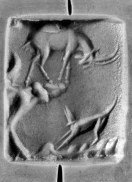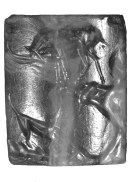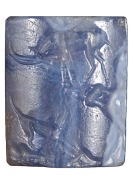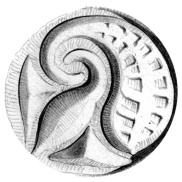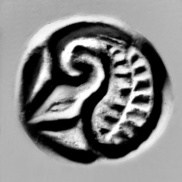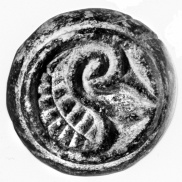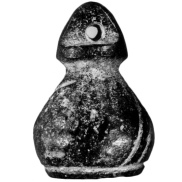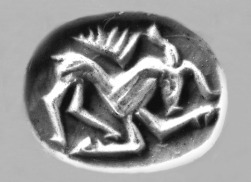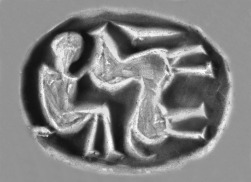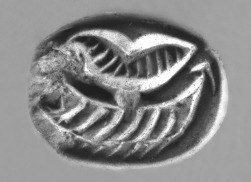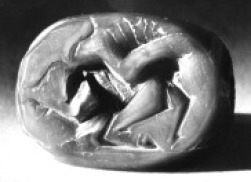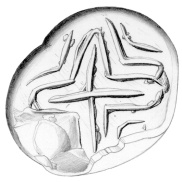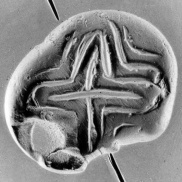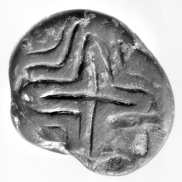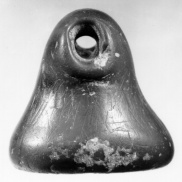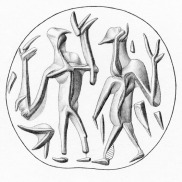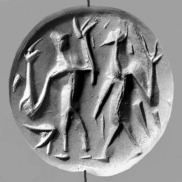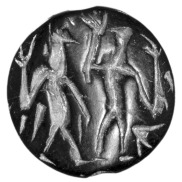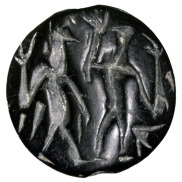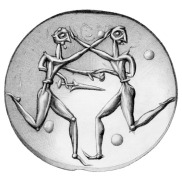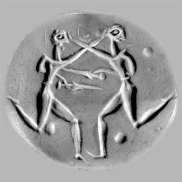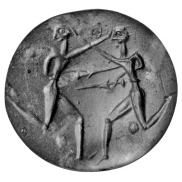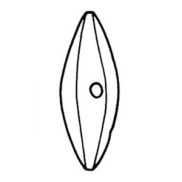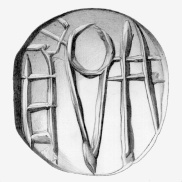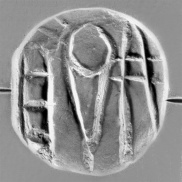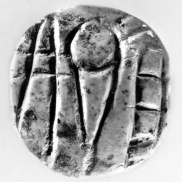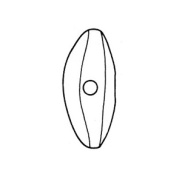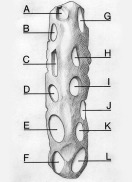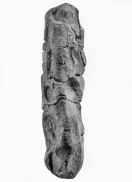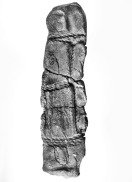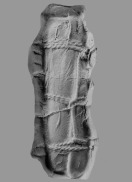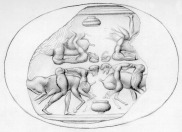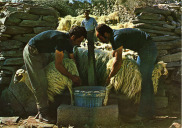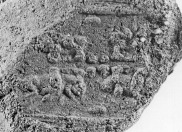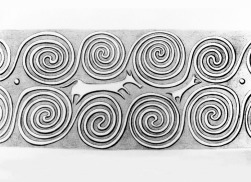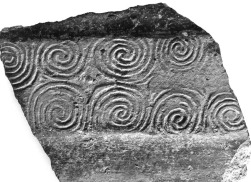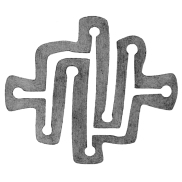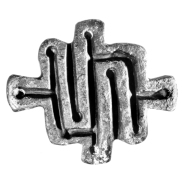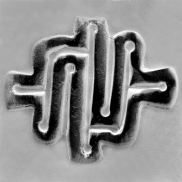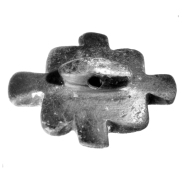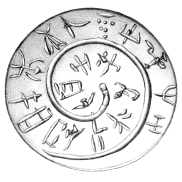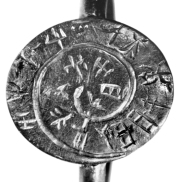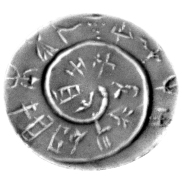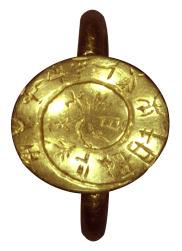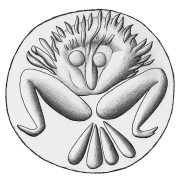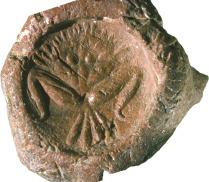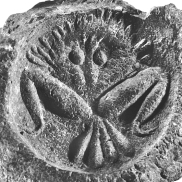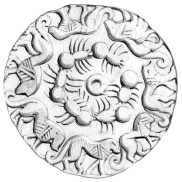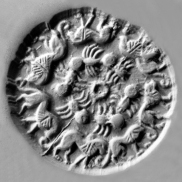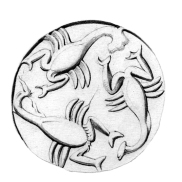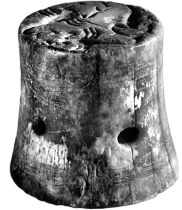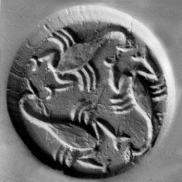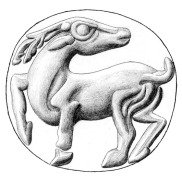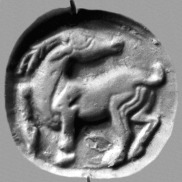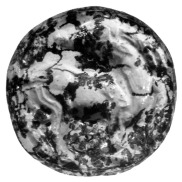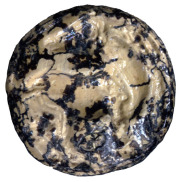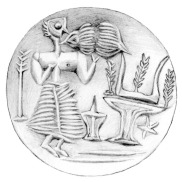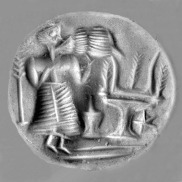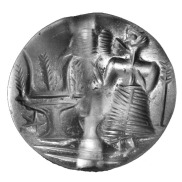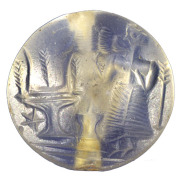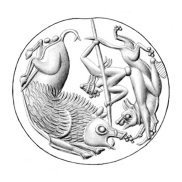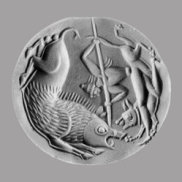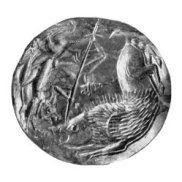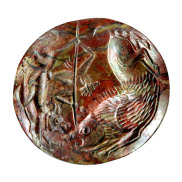Seal of the month - 2013-2019
2018 - 2017 - 2016 - 2015 - 2014 - 2013
2019
Summer 2019
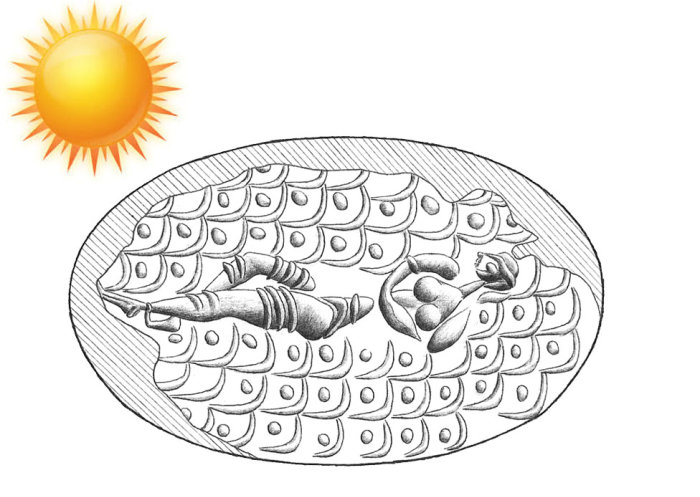
Εις τον αφρόν, εις τον αφρόν της θάλασσας...
Happy summer!
June 2019
CMS VI no. 181; II,6 nos. 44, 43
A cushion and the impressions of two golden signet rings on several nodules
Three seal faces showing different phases of bull-leaping: 1. The animal climbs with its front legs on a quadrangular feature and the bull leaper reaches for its neck in the process of jumping over it. 2. The bull is running (flying gallop) as the leaper grasps its neck and executes a back flip over it. 3. The bull-leaper is in the air behind the running animal with feet directed towards the ground and thus shown in the moment he has completed the jump over the bull and is landing on the ground behind it. In this last image, the bull leaper is shown in frontal view.
CMS VI no. 181: Priene?; Stylistic Dating: MM III/LM I
CMS II,6 no. 44: Agia Triada; but the same impression also from Gournia, Sklavokambos. Stylistic Dating: LM I. Context: LM IB
CMS II,6 no. 43: Agia Triada; but the same impression also from Gournia, Sklavokambos, Kato Zakros; Stylistic Dating: LM I. Context: LM IB
Commentary
The strength of the animal is expressed by its voluminous muscular body and the athletic feat of the bull-leaper with his, by contrast, ‘elastic’ sinuous frame. Bull-leapers on neopalatial seal faces are fine and agile figures while after LM II, bull-leapers become larger and heavier, in some cases shown even larger than the bull.
Evans was the first to try to reconstruct the phases of the Minoan sport. Following Evans and then Sakellariou’s work, John Younger suggested that Aegean bull-leaping images depict three different ways of executing the sport. In Evans’s Schema (mainly neopalatial, see also here) the leaper grabs the animal by the horns, does a back flip over its back, steps on its rump and jumps over it again towards the ground. In the Schema of the Diving Leaper (LB I-III) the bull leaper dives towards the shoulders of the bull from a higher point, and then carries out a handspring and back flip to land on the ground behind the bull. In The Schema of the Floating Leaper (LB III) the leaper is always shown above the bull with his front side facing the animal’s back and his legs bent. This latter schema is mainly found on seals of the last phases of the Late Bronze Age and is more favoured in the mainland than on Crete. Given the late dating of this schema, the stronger connection with the mainland and the fact that the leaper is always shown ‘frozen’ in the same position, Younger has suggested that this latter scheme could be a decorative one developed from images of bull-leaping when the sport was not executed anymore (and/or at places where it was never executed). Younger has also suggested that among the three schemas the only one that seems to realistically depict the sport is the second, the Schema of the Diving Leaper.
According to Younger, the first image presented here belongs to his second scheme, the second to his first and the third to both (Younger’s ‘alighting leapers’). However, as the images are placed here, they appear to belong to the same general type of execution of the sport, especially as the leaper in both the first and the second image grasps the animal’s neck (and not horns: Evan’s Schema). It is therefore possible that they both belong to the Schema of the Diving Leaper and represent scenes from the actual sport.
Maria Anastasiadou
References:
A. Evans. 1930. The Palace of Minos, III. London (MacMillan).
J. Mcinerney. 2011. Bulls and Bull-Leaping in the Minoan World. Expedition 53.3: 6-13.
A. Sakellariou. 1958. Les cachets minoens de la collection Giamalakis. EtCret 10. Paris (Geuthner).
J. G. Younger. 1976. Bronze Age Representations of Aegean Bull-Leaping. AJA 80.2: 125–37.
March/April 2019 (by Fritz Blakolmer)
CMS I no. 379
Impressions of a metal ring on three clay nodules
A symmetrical composition consisting of a central divine figure of female sex, as indicated by the breasts, which is flanked on each side by a scene that combines two creatures: a bull that is accompanied by a Minoan genius with a distinct type of knife.
From Pylos, Palace, Southwest Building
Context: LH IIIB2 destruction horizon
Stylistic dating: LB II late/LB IIIA1
The nodules are kept at the National Archaeological Museum of Athens
Commentary
Although this image of a metal ring is attested by three fragmented seal impressions, only its upper part is preserved and thus permits us to discuss merely half a ‘seal image of the month’. From a typological point of view, it presents the emblematic, symbolic motif of a Potnia Theron which is popular mainly in post-Neopalatial glyptic. Its distinct iconography, though, is unique and worth a closer analysis.
The goddess in the centre with naked torso, raised arms and, as it seems, short hair wears a variant of the so-called ‘snake frame’ upon her head. This figure clearly belongs to the Minoan type of the ‘Goddess with Snake Frame’ that is well-known especially in the glyptic of post-Neopalatial Crete. In this seal image, though, the special head-dress exhibits some familiarity with a polos decorated with multiple horns sticking out on both sides inspired from Near Eastern or Hittite images. Furthermore, this Minoan headgear is crowned by a symbolic double-axe and a rosette.
The Minoan figure of the ‘Goddess with Snake Frame’ normally appears as flanked by griffins or lions and can probably be associated with the throne-room of the palace at Knossos with its mural painting of antithetical recumbent griffins guarding the throne and the figure seated on it respectively. In contrast to that, the goddess in the seal image from Pylos is flanked on both sides by completely different figures: instead of ‘creatures of power’ that are subdued by the goddess, an entire scene is represented that can be reconstructed as the motif of a bull and a Minoan genius crossing each other; most probably the demon stands behind the bull. Although Minoan genii were occasionally depicted as flanking and protecting divine figures, in the present image they rather seem to guide the bulls – a common Minoan seal motif. In the iconography of the entire Aegean Bronze Age bulls almost never appear as attendants of or dominated by male or female deities making an interpretation of the bulls as protecting animals of the ‘Goddess with Snake Frame’ in the Pylos seal image highly improbable.
The key for our understanding of this unique image could be the knife which is not really held by the Minoan genii but simply added to their hand-like paws, probably in order to present this type of knife in its entirety. Although the knife with a terminal ring is well known from a series of archaeological contexts, the definition of its exact function causes some problem to us. Nonetheless, its probable occurrence in ritual scenes such as the procession fresco in the staircase of Xeste 4 at Akrotiri in Thera suggests that this type of knife should not exclusively be seen as a battle-knife but was associated with offering or that ritual slaying was at least one of the purposes of this instrument. Thus, if my interpretation is correct, the lateral motifs of this seal image can be read by us as a Minoan genius with a slaughtering knife in his hand and accompanying a bull. As a consequence, the common emblem of a Potnia Theron was combined with the pictorial allusion to a ritual scene that can hardly be interpreted other than the slaughtering and offering of a bull. In Aegean imagery the figure of the Minoan genius is often depicted in motifs that can be associated with sacerdotal functions such as transporting quadrupeds (to be offered) or holding their characteristic libation jug. It forms a striking peculiarity of Aegean iconography that no human figure was depicted in conducting or alluding to sacrificial rituals in front of a deity. In order to circumvent this obvious taboo, the Minoan genius replaced human worshippers or priests.
As a consequence, the divine image of this LB II-IIIA metal ring exemplifies well a certain distance from the standardized Minoan iconography. The original form of the orientalising ‘snake frame’ seems to have been replaced by a slightly different head-gear inspired by the Near East. Instead of the conventional creatures of power, the goddess is flanked by an unusual motif alluding to bull sacrifice conducted by a hybrid being of semi-divine character, the Minoan genius. This highly complex seal image, therefore, is full of symbolism and exhibits a new iconographical creativity by combining traditional Minoan elements with old and possibly also new inspirations from the Near East, perhaps in a kind of ‘interpretatio mycenaea’, and by presenting the deity in closer relation with the sacrificial ritual in its honour.
Fritz Blakolmer, Vienna, March 2019
References
I. Pini, Die Tonplomben aus dem Nestorpalast von Pylos (Mayence 1997) 7-8, cat. no. 12, pl. 4.
F. Blakolmer, Mycenaean iconography: dependency, hybridity and creativity, in: P. P. Iossif - W. van de Put (eds.), Greek Iconographies: Identities and Media in Context. A Seminar organized by the Netherlands Institute at Athens and the Belgian School at Athens, Pharos 22(1) (Athens 2016) 27-47, esp. 33-35.
F. Blakolmer, Il buono, il brutto, il cattivo? Character, symbolism and hierarchy of animals and supernatural creatures in Minoan and Mycenaean iconography, Creta Antica 17, 2016 (2018), 97-183.
February 2019 ('Dinner for two: Minoan Valentine')
Impression of a soft stone lentoid on a string nodule
Two humans in profile are standing on either side of a tripodic vessel (tripod cooking pot?) and hold an oblong object in its interior. Above the pot, there is a plant element.
Stylistic dating: Late Bronze Age
Commentary
The right figure is wearing a long garment that could represent a dress or skirt but probably not a robe since it does not appear to be fastened in the front. Because of this the CMS has identified the figure as female despite the fact that it has neither long hair (loose or tied in a bun) nor female breasts, elements that are commonly used to render female figures.
The two figures are engaged in an action of either stirring something with the help of a rod-shaped element or grinding/crushing with the help of a pestle. While it is not possible to say with certainty what action is depicted, the shape of the vessel which is known to have been used in cooking could suggest that the figures are involved in the act of food preparation. The image on this seal could, therefore, be seen like a snapshot of everyday life in the Bronze Age Aegean.
Such images are rather rare on Aegean glyptic and, when they appear, they provide an exceptional insight into the way of life in these societies. Seal iconography is an invaluable source in our attempt to visualise prehistoric life in the Aegean, especially since no deciphered texts apart from Linear B exist that provide information about everyday life during the Bronze Age. These images can be likened to ‘photographs’ from the past that attest nicely to similarities between life then and now:
Fishing - Sailing - Hunting - Dog welcoming owner - Playing ‘backgammon’ - Milking
Maria Anastasiadou
January 2019 (by Diana Wolf)
CMS XI 244
Cushion seal, bronze (?)
Without provenance
Stylistic dating: LM I–II
A pair of lions and a griffin are engraved in dynamic poses on this seal face. While one lion is depicted bounding from left to right (impression) in the lower part, the griffin is leaping in the opposite direction in the middle of the scene. The second lion is displayed along the left vertical axis and is shown pouncing on the griffin, biting it in the neck. Its body seems to wrap around the griffin and the hindlegs of the first lion, probably a result of the limited amount of space on the rectangular seal face and the attempt to create perspective.
Commentary
Griffins are fantastic creatures of a Near Eastern origin and attested on Crete from MM II/III onwards. The hybrid originated in the early Elamite period, after which its iconography spread to predynastic Egypt. At the beginning of the 2nd millennium BCE, the Egyptian griffin came to Syria before moving on to the Aegean world (Morgan 1988, 49–50; Aruz 2008, 288–90). At each of these stages, its iconography underwent changes. While Classical Antiquity produced griffins of various types, such as lion-, serpent-, or ravener-headed creatures with the winged body of a lion, the Aegean griffin always had the head and wings of a bird of prey and the body of a lion (Delplace 1967, 77–78). These features were taken over from Late Old Syrian and Classical Syrian style (Aruz 2008, 108). All the while, Aegean artisans regularly varied iconographical details and themes and even configured female griffins, which are otherwise unattested in the neighboring cultures.
The griffin proved a popular motif from its earliest time in Crete, a fact proven by early seal impressions from Protopalatial sites such as Malia and Phaistos. Interestingly, it is prominent on further iconographic media such as wall-paintings, painted vessels, and larnakes (for more, see Morgan 1988, 49–54). With 21 known examples of metal seals, mostly in gold, but also in bronze, it is the most prominent fantastic creature featured in this high-value material. There are a variety of griffin depictions, from static single creatures to narrative scenes of hunting and drawing chariots, and finally heraldic compositions and animal-mastery scenes (Blakolmer 2016, 64). Especially in wall-paintings they typically accompany figures of power such as a seated goddess or a real human that would be sitting on a high-backed throne as in Knossos.
Lions, unlike griffins, are animals that occur in the natural world. They did not appear on Crete and were probably chiefly known by their iconography, which was likewise imported from the east. Although some bones have been found on the mainland, the question of the animal’s occurrence remains a matter of scholarly debate. Just like griffins, lions exerted a strong fascination on people in the Bronze Age. They are not only a highly recurrent motif on seals, but, like griffins, they are present on various other media such as dagger pommels and inlaid blades, wall-paintings, vessels and sculpture – most prominently the lion gate of Mycenae (Shapland 2010). Often, they are depicted as predators of fallow, wild goats and even bulls. In other scenes, they are encountered by human warrior-hunters and prove a dangerous prey for them. Thus, lions always afford danger to animals as well as humans. The seal discussed here perpetuates this danger on another level: a metaphysical sphere of fantastic creatures, represented by the griffin.
The relationship of griffins and lions is not immediately clear; while both attack animals of prey, occasionally even together, other scenes show griffins attacking lions or lions attacking griffins. Whereas lions are frequently hunted by humans, there is only one possible case of griffins hunted by men. The creatures’ roles in regard to humans differ from their mutual relation to each another. Moreover, both lions and griffins can appear in heraldic animal mastery scenes, again either with their specimens or, combining one lion and one griffin. To sum up, there is no static hierarchy between both creatures as either can be harmed by the other. However, griffins are more often the attacker than attacked and while both appear in large scale media where they can even be directly associated, griffins were the choice creature as attendants of figures of powers. Nevertheless, a strong analogy of lions and griffins has to be acknowledged for the Late Bronze Age, where both appear as hunters and attendants or protectors (Morgan 1988, 52).
Diana Wolf
References
J. Aruz. 2008. Marks of Distinction. Seals and Cultural Exchange between the Aegean and the Orient (ca. 2600 - 1360 BC). CMS Beiheft 7. Mainz am Rhein (Philipp von Zabern).
F. Blakolmer. 2016. Hierarchy and symbolism of animals and mythical creatures in the Aegean Bronze Age. A statistical and contextual approach. In E. Alram-Stern, F. Blakolmer, S. Deger-Jalkotzy, R. Laffineur and J. Weilhartner,(eds.), Metaphysis. Ritual, Myth and Symbolism in the Aegean Bronze Age; Proceedings of the 15th International Aegean Conference, Vienna, Institute for Oriental and European Archaeology, Aegean and Anatolia Department, Austrian Academy of Sciences and Institute of Classical Archaeology, University of Vienna, 22-25 April 2014. Aegaeum 39. Leuven (Peeters): 61–68.
C. Delplace. 1967. Le griffon créto-mycénien. L'Antiquité Classique 36.1: 49-86.
L. Morgan. 1988. The Miniature Wall-Paintings of Thera. Cambridge: University Press.
A.Shapland. 2010. The Minoan lion: presence and absence on Bronze Age Crete. WorldArch 42: 273-89.
2018
Nov18- Oct. '18 - Summer '18 - Apr. '18 - Feb. '18 - Jan. '18 -
December 2018

Merry Christmas! ... Frohe Weihnachten! ... Καλά Χριστούγεννα!
November 2018 (by Diana Wolf)
Lentoid, green jasper. Hard stone technique (cutting wheel, solid drill)
From Mycenae
Stylistic dating: LB I–II
A pair of antithetically recumbent quadrupeds, both looking right, are engraved on the seal face. Below, a wavy incision marks the ground line or a landscape element. The quadrupeds have an elongated body with two rows of horizontal dashes running from the shoulders until the onset of the tail. These bear resemblance to crocodile scales. The creatures’ tails are held high, inclined towards the body in a curve. Their heads sit atop long necks and are comprised of short, pointed ears, an ellipsoid head with a prominent circle for the eye in its center and a long, two-partite snout ending in a short vertical line. A final distinctive characteristic is the quadrupeds’ short legs with broad paws.
Commentary
The quadruped depicted on the seal face is a composite creature conventionally termed 'Minoan Dragon'. Its unparalleled iconography has led to many wild guesses concerning its identity in the early literature, resulting in classifications as a lion, bull, griffin or even crocodile. With the regular appearance of more creatures of this type, scholarship began to recognize it as a distinct fantastic creature. Its name, Minoan dragon, derives from the fantastic ‘Babylonian dragon’, a creature composed of a long body, neck and tail, a horned head and feline forelegs, but taloned hindlegs.
Its origin is difficult to allocate, as it could either have been imported from abroad and re-interpreted according to Minoan ideas or indeed invented in Crete. While it combines elements of animals known from Minoan iconography, such as its dog-like tail or feline haunches, there are many parallels to Babylonian dragons. Another connection to the latter lies in the broader iconographic repertoire: Mesopotamian gods were depicted standing on the back of Babylonian dragons and in several instances, the Minoan Dragon also acts as a mount ridden by an elaborately clad female figure often addressed as the 'Minoan Goddess' (cf. CMS II,6 no. 33, I no. 167, VI no. 321). The creature’s recurrent depiction in an exotic riverine landscape also points toward a foreign origin.
The Minoan Dragon possibly made its first appearance on Crete in the period MM II where it was depicted with combined elements of dog and lion iconography that soon developed the characteristic features of an elongated body and neck, short legs with paws and the upward curving tail. Its iconography, as exemplified by this seal, becomes more stable and standardized by the period LM I, but it remained open to variation and could be rendered in different styles, such as the ‘Talismanic style’ (cf. CMS XII nos. 290, 291). During LBA I-II Minoan Dragons can appear in pairs, which implies that this was not deemed a unique fantastic creature, but rather a ‘species’ of composite beings, just like griffins or Minoan genii. Seldom do dragons engage in any narrative or activity: they are either represented as recumbent or running specimens, sometimes in a riverine landscape setting with papyrus stalks, in pairs, or as the mount of a prominent female. Its repeated occurrence together with these supposedly divine figures demonstrates its belonging to a metaphysical sphere in Bronze Age cognition. The creatures cease to be represented in glyptic by LBA II–III, a period when they were, however, depicted in plaques and combs rendered in materials of high value, such as gold, ivory and glass. Perhaps it was the rather static representational style with which the fantastic creature was connected and possibly its metaphysical connotations that made it an attractive subject for ornamental use as a symbol on the surface of objects within elite households.
References
J. Aruz. 2008. Marks of Distinction. Seals and Cultural Exchange between the Aegean and the Orient (ca. 2600 - 1360 BC). CMS Beiheft 7. Mainz am Rhein (Philipp von Zabern).
F. Blakolmer. 2016. Hierarchy and symbolism of animals and mythical creatures in the Aegean Bronze Age. A statistical and contextual approach. In E. Alram-Stern, F. Blakolmer, S. Deger-Jalkotzy, R. Laffineur and J. Weilhartner,(eds.), Metaphysis. Ritual, Myth and Symbolism in the Aegean Bronze Age; Proceedings of the 15th International Aegean Conference, Vienna, Institute for Oriental and European Archaeology, Aegean and Anatolia Department, Austrian Academy of Sciences and Institute of Classical Archaeology, University of Vienna, 22-25 April 2014. Aegaeum 39. Leuven (Peeters): 61–68.
M. A. V. Gill. 1963. The Minoan dragon. BICS 10: 1–12.
J.-C. Poursat. 1976. Notes d'iconographie préhellenique: dragons et crocodiles. BCH 100.1: 461–74.
Diana Wolf
October 2018
Lentoid, hard stone. Hard stone technique.
Multiple impressions on a stopper (the stopper is also impressed by another seal face).
Animal sacrifice: A bovid in right profile with the front and back legs tied together in an X-configuration lies on a construction which has at least two legs (altar?). A man in the same profile wearing a belt is standing behind the animal and has his arms outstretched towards its rump. Above the animal there is a pair of horns of consecration and three other intelligible elements.
From Malia, Quartier E (Room IV 2)
Context: LM IIIB
Stylistic dating: LM II–IIIA1
Commentary
The animal’s legs are shown in front of the altar; in other examples they are shown behind the altar. In all these cases we could have attempts to show the animal with tied legs lying on one of its sides, in a way known from the Agia Triada Sarcophagus. In another depiction (see impression) the left front and back leg of the animal are shown in front of the altar and the back legs to its back: here, there is a possibility that the animal is depicted lying with its belly on the altar and legs hanging to either side of it tied together to keep it attached to it. If this reading of the image is correct, the surface of the altar must have been narrow enough for the animal’s legs to be tied on either side of it. The MM II image of two agrimia (wild goats) with crossed legs hanging from a pole carried by a man is a good example on how sacrificial animals with crossed legs could have been tied to an object/construction. Altars on which animals are secured with crossed legs always have two legs.
In a further type of animal sacrifice scene the animal is placed with its back or belly on the altar and has outstretched or bent legs that are, however, not crossed. These animals clearly lie on the surface of the table, either on their back or belly with bent legs. These altars usually have three legs, although there are single examples with four and two legs.
Animal sacrifice scenes are rare in Aegean glyptic. They are most popular on LM II-III seals and are most often encountered on hard stone seals (there is one known soft stone example and one cut in glass). Of interest, however, is the fact that a group of MM II seals which are mostly cut in soft stones displays single animals with crossed legs on their seal faces. The crossed legs of these must signify that they are sacrificial animals with tied legs. The rare cases in which a man is depicted with these animals on these early seals could represent the first examples of animal sacrifice scenes in Aegean glyptic.
Maria Anastasiadou
Summer 2018
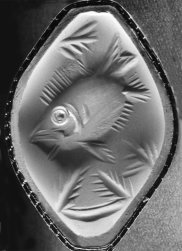
Happy Aegean Summer!
April 2018
CMS VI no. 102
Eight-sided prism. Agate. Hard stone technique.
Inscriptions of the Cretan Hieroglyphic on all sides.
From ‘Neapolis’.
Stylistic dating: MM II.
Commentary
The seal belongs to the so-called Hieroglyphic Deposit Group. The seals in this group are cut in hard stones and are elaborately engraved. They most often carry inscriptions of the Cretan Hieroglyphic and are multi-facial, mainly four- and three-sided prisms. This eight-sided prism is a singular example of a Cretan Hieroglyphic multi-facial seal.
Since the Cretan Hieroglyphic has not been deciphered the meaning of the inscriptions on the sides of this piece is unknown. It has, however, been suggested that the inscriptions on Cretan Hieroglyphic seals could encode different responsibilities of their users in a hierarchical administrative system. The idea behind this suggestion is that each inscription encodes an administrative responsibility and, therefore, the more inscriptions one prism carried the more responsibilities its user would have and higher in a hierarchical system (s)he would be.
Impressions of this type of seals on ancient sealings are common and have been found in Knossos, Malia and Petras. Because of the large number of impressions of these seals in Knossos, it has often been been suggested that they were produced there. However, seals (as opposed to seal impressions) of this group have not (yet?) been found in contexts in Knossos (here p. 167). Instead, their distribution as we know it today suggests a larger connection with eastern Crete. The recent discovery of a large batch of this type of seals in the Petras cemetery reinforces the idea that seals of this group were 'at home' in the eastern part of the island.
Maria Anastasiadou
February 2018 (Minoan Valentine)
Side (a) of a stamp cylinder. Hippopotamus ivory. Soft stone technique.
Copulating scene (?): Two human figures, seated the one (right) on top of the other. The figures are facing each other with their faces close to one another. In the field there are three motifs, an Y-motif (sistrum?), a C-spiral and an S-shaped motif whose ends end in plants.
On side b are depicted three fish, the one above (or next to) the other.
From Viannos, Crete
Stylistic dating:EM III-MM IA
Commentary
This is a unique scene in the Aegean image repertoire possibly showing two human figures in sexual intercourse. Despite the fact that a fighting scene cannot be totally ruled out, the posture and the way the two figures are combined in the image suggest a rather intimate scene between the two figures. There are no physical indicators of the sex of the figures, so it is possible that humans of different or the same sex are depicted. Cases in which human figures are shown in sexual arousal but without corporeal proximity are rare but not unknown from Aegean glyptic. It has been suggested recently that this is the state in which two male figures are depicted on the bezel of a Late Bronze Age signet ring from Pylos in Messenia (Robert Kohl).
Three more images which can be interpreted as copulation scenes are known from Aegean glyptic, all Minoan and all involving copulating agrimia. Of interest is the fact that in the aforementioned seal from Pylos an agrimi is depicted alongside the two male figures. A LM I lentoid depicting two waterfowls the one above the other has also been seen by some as a possible copulation image but this interpretation cannot be taken as certain because the image could also be read as showing two animals the one behind the other.
Maria Anastasiadou
January 2018 (by Nadine Becker)
Evans' 'Cattle Pieces': The lost signet ring from Knossos and the signet rings CMS II,8 nos 233 and 232
Three sealings with impressions of gold (?) signet rings
Knossos. Archives Deposit (Evans; the CMS gives different findspots for CMS II,8 nos. 232, 233).
Context dating: LM IB/II–LM III
Stylistic dating: LM IB–II (?)
The first impression is lost today and only known through drawings published by A. Evans. The second and third impressions are published as CMS II,8 nos 233 and 232 respectively.
Description
A. ‘Boy leading beast’
The lost impression shows a scene possibly connected to the dairy sector: At the outer right preserved part of the scene a man in right profile is trying to lead a cow/bull in his direction. The animal does not seem to be willing and is turning its head back, gazing in the opposite direction. Its right front leg, the only preserved in the picture, is either shown in a standing or only slightly moving position. This might explain why the legs of the man are even more stilted while trying to pull the animal. Although the outer right part of the impression is badly preserved, the man also seems to turn his head back towards the animal, strengthening the rather fierce action of dragging the animal involuntarily. In the central part of the impression a numeric Linear B sign (variation of 100?/1?) incised in clay is partially visible.
B. ‘The prize ox’ (CMS II,8 no. 233)
Preserved parts of the impression show the head and the upper body of a standing male figure in left profile, obviously supporting himself on a fence. While one arm is bent, he seems to reach out in the direction of a recumbent bull while gazing at him from his resting position. The scene has a quiet intimate and placid character which results from the fact that the two characters show intersecting gazes, they are located close to each other and the man seems to reach out to touch the bull which is neither escaping nor attacking.
C. ‘Boy milking cow’ (CMS II,8 no. 232)
At the outer left part of the preserved impression a man in right profile is slightly bending forward in order to reach the udder of a standing cow. Only the hind legs and a small part of the body of the animal are preserved, but a part of the right horn, visible above the right hind leg, indicates that the animal is actually turning its head back in direction to the man. At the same time, the hind legs and hoofs are shown in a tensed, moving position, probably suggesting that the animal is either struggling to escape the situation or might have been caught by surprise by the man.
Commentary
The gold signet rings known today (98) are outnumbered by the impressions of signet rings that only survive on clay sealings (252). The surviving rings and ring impressions generate a catalogue of 350 so far known unique pieces, each of which represents a masterpiece of Aegean art. As it seems, gold signet rings were ever since valued due to their highly complicated and time-consuming manufacture, but at the same time the rate of reuse of the material must have been very high. This is the reason why gold signet rings and metal seals in general seem to have a quite low rate of archaeological transmission.
As if the loss of the actual rings was not bad enough, some of their impressions got lost in modern times and with them, the knowledge about their existence. The lost impression of the signet ring from Knossos is among those pieces. Together with CMS II,8 nos 232 and 233 the sealing was drawn by A. Evans in his 1902 notebook and then published in The Palace of Minos IV, 2 (1935) in a chapter about the 'Late Minoan Vogue of true "Cattle Pieces"' together with another drawing of a red jasper lentoid. The lost impression is of high importance for enriching our knowledge about scenes of everyday life in Aegean glyptic, as already noted by Evans. Together with the other two rings it highlights several stages of the complex human-animal interaction depicted in bucolic scenes reaching from intimacy (CMS II,8 233) to simple obedience (lost impression).
When coming to the reconstruction of seal shapes, it is certain that the ring that impressed CMS II,8 no. 233 was made of gold: the ellipsoid and elongated outline of the seal face can only have belonged to a metal signet ring. Although the seal shapes of CMS II,8 no. 232 and the lost signet ring were recontructed in a more ‚swaged’ way in the Palace of Minos IV, a possible discoid seal shape can be ruled out. The inclination of the preserved outline and the fact that in both cases large animal bodies have to be complemented leaves no doubt that these impressions were also made by gold signet rings.
Commentary on the imagery of the three sealings
A: The theme ‘man leading animal’ is quite common in Aegean glyptic but the ‘revolting’ of the tamed animal is only rarely shown. A signet ring impression that could be seen as showing two goats revolting against the robbery of their kids is an exception concerning signet ring iconography.
B: The scene is a rare piece of Aegean art showing a peaceful union of a man and a once wild animal not involved in a combat scene, a hunting scene or placed in an antithetical composition. With the exception of an image with a similarly recumbent bull chained up to an altar that shows parallels to the ‘fence’ in this impression, the scene is without parallels in signet ring iconography. Peaceful interactions of humans and animals are sometimes visible in scenes primarily showing seating female deities like the Potnia Theron or the Potnios Theron. Such images are also encountered on several signet rings and signet ring impressions.
C: The cow turning back its head is a well-known motif in Aegean glyptic and is also encountered on signet rings and signet ring impressions. However, milking scenes, which belong to the seldom ‘genre/bucolic scenes’ that show men and women in everyday actions, are extremely rare. Another superb example of such a scene is the ‘bucolic’ scene impressed on a sealing from Chania.
Bibliography
Evans 1935
A. Evans. 1935. The Palace of Minos. A Comparative Account of the Successive Stages of the Early Cretan Civilization as Illustrated by the Discoveries at Knossos, IV, 2. Camp-Stool Fresco, Long-Robed Priests and Beneficent Genii; Chryselephantine Boy-God and Ritual Hair-Offering; Intaglio Types, M.M. III–L. M. II, Late Hoards of Sealings, Deposits of Inscribed Tablets and the Palace Stores; Linear Script B and its Mainland Extension, Closing Palatial Phase; Room of Throne and Final Catastrophe. London (Macmillan and Co., Limited).
Gill 1965
M. A. V. Gill. 1965. The Knossos sealings: Provenance and identification. BSA 60: 58–98.
Popham – Gill 1995
M. R. Popham – M. A. V. Gill. 1995. The latest sealings from the palace and houses at Knossos. BSA Studies I. Oxford (Alden Press).
Dec. '17 - Nov. '17 - Oct. '17 - Summer '17- June '17 - Apr. '17 - Mar. '17 - Feb. '17 - Jan. '17
December 2017
For full HD resolution video see here
3D Animation: Dionyssis Antypas
November 2017
Conoid clay stamp without a stringhole with an impression of the impression of a lentoid (hard stone). The clay is burnt either on purpose or accidentally.
Animal attack scene: A lion in left profile is attacking a hoofed quadruped (bovid?) in right profile. The lion is turning its forepart backwards and steps on the quadruped's back to bite it on the neck.
From Knossos, Palace, Corridor of the Stone Basin
Stylistic dating:LB II-IIIA1
Commentary
The clay was formed in the shape of a conoid and impressed on the impression of a lentoid. This way a stamp with intaglio was created which could be used in place of the lentoid. For this reason, and despite the fact that the stamp was created by impressing, this object can be seen as a seal.
This is a rare attestation of an attempt to create the copy of a seal. The stamp’s conoid shape, its concave sides and the ‘intaglio’ on its base make it appropriate for handling as a seal. However, the fact that it does not have a stringhole means it could not be carried by being hanged on the body. The object could have been created for legal (e.g. need of a duplicate in the administrative sphere) use or represent a successful attempt to counterfeit a seal for illegal use.
Two other conoid clay stamps are known from the Aegean, one from Malia and the other from Knossos, and they could have had a similar function as CMS II,8 no. 362. A fourth clay object with the impression of a signet rings’s impression (here image Pla1) that comes from Knossos looks more like a large nodulus (type of nodule) and would not have been appropriate for use as a stamp. It is probable that in the case of this object, the signet ring that was needed to impress it was not at hand but another nodule with the ring's impression was available (possibly one of these here: images Pla2-4): this impression could have been used to impress the nodulus as a substitute for the signet ring.
Maria Anastasiadou
October 2017
Barrel-shaped. Agate. Hard-stone technique.
A man is standing in right profile among five columns, two behind him and three in front of him. The man has short spiky hair combed backwards, one arm down and one arm bent upwards in front of him. He is wearing a belt, a bracelet and, possibly, a short garment around the pelvis. The columns behind the figure have a double base but those in front of him double capitals. The bodies of the columns have relief decoration that could be interpreted as fluting: two have vertical fluting, one spiral fluting, and two spiral fluting on top and vertical on the lower part. A linear element just behind the figure could hypothetically represent an attempt to render a sixth column with a double capital and a single base in the background.
From Mycenae, Chamber Tomb 68
Stylistic Dating: LB II-LB IIIA1?
Commentary
This is a rare representation of a human shown standing in what appears to be an architectural setting represented by columns. The fact that the man has the same dimensions as the columns suggests that the human figure was the centre of interest in the representation and the columns were added as secondary elements, probably in order to suggest a ‘colonnaded’ area in which the figure was standing. The setting could represent an open or closed space. The absence of a roof line does not, however, necessarily suggest that this is an open space but is more probably a practicality connected with the fact that the figure is as large as the columns: if a roof line ahd been rendered on top of the columns, the man’s head would be very close to it and this would make the unnaturally large size of the figure immediately obvious.
Scenes with humans in association with columns are rare in Aegean glyptic. In such scenes, the columns appear as single elements and function more as symbols and less as indicators of architectural settings. The closest parallel to the scene on CMS I no. 107 is the representation of a female figure standing between two columns on a Minoan soft stone seal of unknown provenance. However, the columns here are shorter than the figure and were probably meant to have a symbolic meaning as opposed to a function of supporting a roof.
Barrel-shaped seals are differentiated from cylinder-seals by the fact that they have tapering ends. They are only represented by a handful of examples in the Aegean Bronze Age and date to LB I-IIIA1. Examples of this type of seals come from the mainland, the islands and also Crete.
Maria Anastasiadou
Summer 2017
Happy Aegean Summer!
June 2017
Lentoid. Serpentine/Schist. Soft stone technique.
A bird lady with the head in left profile.
Stylistic dating: LM I
Commentary
The term bird lady describes a Minoan hybrid that stands upright like a human and has features of a bird from the waist to the head and, from the waist downward, the lower body of a woman wearing a long skirt. Most bird ladies stand with their body depicted frontally and their head shown in profile looking to the side or up. There are, however, some bird ladies with their torsos shown in profile and a rare example of a bird lady shown entirely in profile and sitting .
It is not always easy to differentiate between depictions of bird ladies and birds on seals, since the triangular feathered tails of birds can sometimes look like skirts. The decisive criterion for telling bird ladies apart from birds are the legs: if there are legs under the triangular lower part of the depiction, the creature is a bird lady. There are a few cases, however, in which bird ladies do not show legs but are recognized as such by the prominent folds on their skirts. With one exception, whose authenticity may be contested, proper bird ladies do not have female breasts as their torso is that of a bird. Creatures that look like bird ladies but have breasts belong to a different category of hybrids that do not have a standard form but show different elements in each existing version (see here).
25 depictions of bird ladies, most of which are engraved on lentoids, have been published at the CMS. All bird ladies appear on soft stone seals and many are engraved in a rather sketchy manner. Among them, less than a half have a known provenance and only two come from a dated context. The extant examples are, however, dated to LM I on the basis of stylistic considerations.
Since hybrids were part of the metaphysical belief system of the Minoans, their appearance on seals confirms that some seals also had, among others, a protective function for their users. The connection of bird ladies with seals cut in soft local stones and in a sketchy manner is an indication that these creatures were connected with a Minoan folk belief. It is perhaps no chance that some bird ladies are very similar to certain birds on talismanic seals, which are objects that must have had an increased amuletic character.
Maria Anastasiadou
April 2017 (Easter Bunny by Olga Krzyszkowska!)
Stepped pyramid with roughly square seal face. Carnelian: hard stone technique.
A recumbent animal to the left; a series of fine vertical lines in the background.
Armeni Cemetery: chamber tomb 38
Context dating: LM IIIA2–B1
Stylistic dating: MM II
Commentary
In almost every respect — motif, shape, material, and context — CMS V no. 263 is unusual. The motif comprises a recumbent animal, deeply engraved, which occupies virtually the entire seal face, square in shape; surrounding the animal are lightly engraved vertical lines. The animal’s head is formed by a large solid dot; another solid dot represents the eye. The mouth is open, with a dot indicating the nose and a short line for the jaw. Beneath a short but slender neck the animal’s body is rather bulky, with little sign of modelling. The forelegs project from beneath the chest and terminate in simple solid dots. The near hind leg extends from the rump and is bent sharply and rather clumsily to form an unnaturally elongated lower limb, set near the edge of the seal face. Only the lower part of the far hind leg appears beneath the animal’s belly. The tail is held almost erect, curving very slightly. All in all the proportions of this creature are decidedly odd and in no way conform to representations of goats and bulls in the MM II repertoire (or indeed later). But most striking by far are the features projecting at right angles from the head and running parallel with the animal’s back — resembling the elongated oval ears of a rabbit or hare, and not the curving horns of a goat or bull.
While rabbits (Oryctolagus cuniculus) are a west Mediterranean species, probably not brought to the Aegean until the Roman period or later, the hare (Lepus europaeus) appears in the Cretan faunal record from the Middle Minoan period through to the Byzantine era, and indeed is still present on the island today. It is likely that the species was deliberately introduced, since there is as yet no evidence for hare in the fossil (Pleistocene) record. Although hare seem to be ubiquitous, in that they are attested in all parts of the island during Minoan times, the quantity of faunal evidence is slender, with sites often yielding no more than a single bone or two. This is largely explained by the fragility of the bones and post-depositional factors. Nevertheless, one imagines that they served as useful sources of pelts and protein. Yet apart from the single possible representation on CMS V no. 263, hare are entirely absent from the iconographical record. This also applies to other small mammals, such as the badger (M. meles arculus) and the beech or stone marten (Martes foina), both probably present in Crete since the Pleistocene and attested in Minoan contexts.
The seal shape — a stepped pyramid — is highly unusual: only four examples are known. Of these two rather low pyramids, made of bone, are firmly datable by both context and style to the late Prepalatial period, EM III–MM IA (from Gournes and Archanes). A third example (now in the British Museum and said to come from excavations carried out by Sir Alfred Biliotti in Rhodes) is made of either chlorite or serpentine and has a simple design comprising circles and diagonal lines; it is datable to MM II. Although the ‘steps’ of the London seal are now worn smooth, it provides the closest parallel to the shape of CMS V no. 263 from Armeni. Stepped pyramids are normally furnished with suspension holes just below their apex. Originally this also applied to the Armeni seal, but at some point in its life the apex and piercing were damaged and a new suspension hole was provided lower down.
CMS V no. 263 is made of carnelian, but only about one-quarter of the seal displays the typical translucent orange-red hue associated with this material. Virtually the entire seal face, and three sides of the stepped pyramid, are opaque and creamy white in colour. In some areas (though not on the face) patterns of very fine cracking (craquelure), veining or irregular blemishes can be observed, showing up as slightly darker than the cream-coloured ground. These features strongly suggest that at some point the seal was exposed to high temperatures, if not to fire. While similar changes to colour, opacity and structure are often observed on Aegean seals made of agate, carnelian and chalcedony, only limited experimental work been undertaken in controlled laboratory conditions, in order to document the various structural changes involved and length of exposure to heat/fire that they represent.
The seal came to light in chamber tomb 38 in the large Armeni cemetery, south of Rethymnon. Altogether more than 225 tombs have been excavated here, most dating to LM IIIA2/B. Roughly 30% of the tombs contained at least one seal: about 165 were recovered in total, far exceeding the number known from any other cemetery in the Bronze Age Aegean. Another phenomenon observed at Armeni is the high proportion of ‘antique’ seals, which are older — sometimes significantly older — than their context. Roughly 20% are datable to LM I–II or earlier; these include numerous seals in the MM III–LM I ‘talismanic’ style, a MM II–III rock crystal discoid with ‘architectural’ design and even a MM I pierced conoid. It is entirely possible that such antique seals survived by being incorporated into necklaces. Indeed listed among the finds from tomb 38 are beads from a necklace (without further details), along with a sword and dagger (both of bronze) and some eight vases of various shapes. As yet no information exists regarding the number or sex of the burials: further details may become available when the cemetery is finally published.
Irrespective of context date and its many unusual features, CMS V no. 263 can be firmly dated to MM II. Although only one other stepped pyramid of this date exists, the concept fits well with the popular loop-handled seals or Petschafte, common in this period. Carnelian and other semi-precious stones made their appearance in MM II and were invariably engraved with rotary technology, also introduced in this period. The motif, however, is truly unique. The vertical lines in the background are unparalleled: while they may be no more than horror vacui, they might be construed as indicating an enclosure or fencing of some kind. The animal has no parallels whatsoever among depictions of sheep, goats, pigs, bulls, or deer in MM II or later, and indeed the proportions are entirely wrong for ungulates. It is, of course, conceivable that the engraver simply made a series of miscalculations regarding the space needed to execute the design and to incorporate curving horns. But MM II was a period of great experimentation in Aegean glyptic, not only in respect of technique, but also in the expansion of the iconographic repertoire. Cats and deer, perhaps first introduced to the island in MM II, now make their first appearance in the glyptic record, as do exotic Mischwesen (griffins, sphinxes and the Minoan genius). The long ears, and for that matter the elongated hind leg of the creature depicted on CMS V no. 263, undoubtedly conjure up the notion of a hare. Whether by chance or design remains an open question.
References
Krzyszkowska, Olga. 2011. Seals and society in Late Bronze Age Crete. In: Πεπραγμένα Ι′ Διεθνούς Κρητολογικού Συνεδρίου A1, 434–48. Χανιά: Φιλολογικός Σύλλογος «Ο Χρυσόστομος»
Krzyszkowska, Olga. 2014. Cutting to the chase: hunting in Minoan Crete. In George Touchais et al. (eds.), PHYSIS: L’environnement naturel et la relation homme-milieu dans le monde égéen protohistorique, 341–47. Aegeum 37. Leuven: Peeters.
Masseti, Marco. 2012. Atlas of Terrestrial Mammals of the Ionian and Aegean Islands. Berlin/ Boston: De Gruyter, esp. 49–59.
Moody, Jane. 2012. Hinterlands and hinterseas: resources and production zones in Bronze Age and Early Iron Age Crete. In: Gerald Cadogan et al. (eds.). Parallel Lives: Ancient Island Societies in Crete and Cyprus, 233–71; esp. 246–47. BSA Studies 20. London: British School at Athens.
Yule, Paul – K. Shurman, Technical observations on glyptic. In: Ingo Pini (ed.), Studien zur Minoischen und Helladischen Glyptik. Beiträge zum 2. Marburger Siegel-Symposium 26.–30. September 1978, 273–82. CMS Beiheft 1. Berlin: Gebrüder Mann.
Images
Colour images by Olga Krzyszkowska. Copyright: Olga Krzyszkowska.
Olga Krzyszkowska, Institute of Classical Studies, London
March 2017
Seal impression of a soft stone (?) lentoid on two two-hole handing nodules
A human forearm wearing two bracelets in left profile is shown holding a large lily.
From Knossos, Palace, Queen’s Megaron
Stylistic dating: LM IB
Commentary
The forearm starts at the edge of the seal face, an artistic convention which is used to suggest that the representation is part of a larger image, that of a human holding a flower. The representation on this face is then, literally, a Minoan close-up.
Images of humans holding flowers are only encountered on a few Aegean seals. All these seals are cut in precious materials, i.e. metals and hard stone, and in all cases the flowers are held by female figures. Most figures in these images hold lilies but one is also depicted holding a papyrus, another poppies and a third an unidentifiable flower. The motif of a woman holding flowers seems to be connected with the sphere of the ritual since most of the images in which the motif is encountered also contain symbols that are well-known from the Minoan ritual, such as horns of consecration, the sun and the moon, and a monkey holding a basket.
Close-up images are rare but not unheard of in Aegean seal imagery. The first image that can be identified as such is the EM III/MM IA depiction of four ‘parading’ lions whose rumps end at the edges of the seal face. The presence of the animals' hind legs is suggested but the legs themselves are not depicted. In MM II there is a rare representation of the protome of an agrimi and that of the intricate forepart of a deer whose neck and waist respectively end at the edge of the seal face suggesting that the body continues. In the Late Minoan period, there is a larger variety of representations that can be interpreted as close-up images. These are the depictions of animal protomes ‘cut’ at the shoulders, boats whose one half is omitted, humans walking in front of friezes which end at the seal face’s edge and animals in a landscape that seems to continue beyond the seal face edges. In the Early Bronze Age, ornamental rapport patterns which cover the whole of the seal face may also be seen as close-up views of larger ornamental patterns.
Maria Anastasiadou
February 2017
Round flat seal face, soft stone. Soft stone technique.
Three impressions on a direct object sealing.
A standing man and a standing woman in profile are facing each other. The woman has shoulder long hair and wears a long chequered skirt/dress. A short vertical line is engraved between the faces of the figures and a branch motif is seen upside down behind the head of the female figure.
From Phaistos, Palace, Room 25
Context: MM IIB
Stylistic dating: MM II
Commentary
The arms of the figures are hanging either side of the body. The left arm of the male and the right arm of the female figure are abutting at their edge, as if the two figures were holding hands. It is not certain whether this is intentional or came about by chance due to the restricted space on the seal face, which has a diameter of just 1,15 cm. Irrespective of this, the image creates the impression of intimacy between the two figures because they are facing each other, and possibly, looking at each other.
Men and women are occasionally combined in one image on Aegean seals. In the vast majority of cases, the images in which male and female figures are encountered together show some connection with the sphere of the metaphysical. In an image that could represent an excerpt from a Minoan story for example, a male figure is holding the hand of a female figure in front of a dinghy. A small female figure floating in the sky above the dinghy suggests that this scene is in some way connected to the sphere of the religious. In another occasion, a standing male extends the arm to that of a large female figure who is depicted seated opposite him. A small seated figure is floating above the arm of the male figure and could, in a bold interpretation, perhaps be read as a toddler in what would then be a rare occasion of straightforward (as opposed to symbolic) expression of fertility veneration. The iconographical vocabulary of the image, e.g. the seated female figure and the dotted line floating in the sky, which are often encountered on scenes with a religious character, would also suggest some connection with the metaphysical.
More, at least seemingly, mundane depictions of the two sexes are rare on Aegean seals. Apart from the Phaistos image, a unique representation on a prepalatial stamp cylinder appears to depict sexual intercourse between two figures (man and woman?). On another occasion, a male and a possibly female figure (long skirt) are depicted either side of a tripod vessel. The figures are holding a linear element in the interior of the vessel in what could conditionally be seen as a scene of food preparation. In a signet ring from Tiryns, two pairs of a male and a female figure are shown interacting in front of a ship.
Maria Anastasiadou
January 2017
Image c: Flat ellipsoidal seal face, soft stone. Soft stone technique.
Image d: Most probably the backside of a soft stone seal with undulating back.
Numerous impressions on the surface of a direct object sealing that was fastening a lid made of bast to the mouth of a pithoid vessel. The sealing, which has been preserved in fragments, formed a circle by lining the mouth of the vessel. Depicted here are a fragment of the sealing (image b) and two silicon imprints of four of the impressions (images c, d).
Image c: An outline ellipse is divided in two by a line which runs along its major axis. Two dots sit antithetically on the form’s outline.
Image d: No motif.
From Malia, Quartier Mu, Building A (Room III 17)
Context: MM IIB
Stylistic dating: MM IIB
Commentary
The seal impressions are scattered on the whole surface of the sealing. Since the seal was small and the diameter of the vessel’s mouth much larger, the seal was impressed many times on the surface of the sealing. This was an attempt for the lid of the vessel to be secured better from unauthorized opening: if no part of the sealing stays without a seal impression, no part of it can be broken and mended again without the party authorised to the contents of the vessel noticing.
Half of the sealing is impressed with a seal face and the other half with what seems to be the backside of a seal. In both cases, the edge of the seal user’s thumb or index finger has been impressed next to the seal along one of its long sides (images c, d). If it is assumed that there was only one seal user, a hypothetical reconstruction of the events that resulted in the sealing carrying impressions of two different surfaces is the following: The seal user was using the seal to impress the sealing when, at about halfway of this process, the process was interrupted. When work was resumed, the seal was grasped without much thought or checking that it was being held correctly. As a result of this and probably without the seal user noticing, the seal was impressed on the remaining half of the sealing with the backside instead of the seal face. If this version of the events is correct, it would mean that the process of sealing was taking place mechanically without much attention to the quality of the impression. Recognizing the seal face in the impression would have been less important than the act of sealing itself which is what would have provided a guarantee that the contents of the vessel were untouched.
The maximal length of the finger edges is 1.29 cm (edge next to the seal face) and thickness 0.63 cm (edge along the backside of the seal). In one of the casts kept at the CMS Archive, the edges of both the thumb and the index finger between which the seal was kept can be seen either side of the seal. The seal face finds no good stylistic parallels but its (?) backside provides a good hint for dating: this was a foliate back, a seal shape which is dated to MM II.
Maria Anastasiadou
Dec. '16 - Nov. '16 - Oct. '16 - Summer '16 - June '16 - May '16 - Apr- '16 - Mar. '16 - Feb. '16 - Jan. '16/Dec. '15 -
December 2016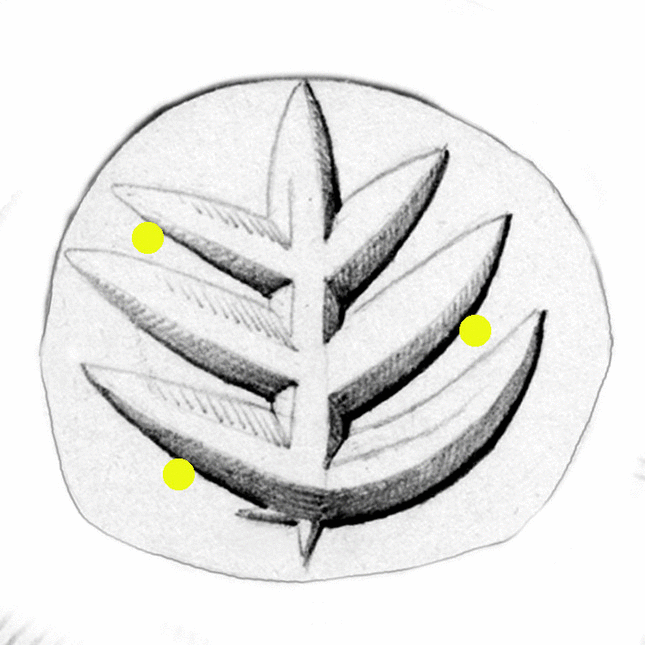
November 2016
Round convex seal face, soft material. Soft stone technique.
Impression on a flat-based nodule
Three hands are placed the one above the other directed alternatingly to the left and to the right. The thumb is separated from the other fingers with are stretched to the front. Around the wrists there are double bracelets in the form of wavy lines.
From Kato Zakros, House A, Room VII
Context: LM IB
Stylistic dating: LM I
Commentary
Depictions of hands are rare in Minoan seals and when encountered, they are most often found on seals that date to the Middle Minoan period. The best parallel to the Kato Zakros hands is the depiction of a hand in front of interlace motif engraved on a seal face impressed on a sealing from Knossos. A hand with four fingers is seen on one side of a seal connected with the so-called Archanes Script. Hands on Middle Minoan II seals function as signs of the Cretan Hieroglyphic.
A magnificent find from Akrotiri may help understand the Kato Zakros hands better. This is a wooden (!) set of two small hands which have been uniquely preserved in the layer of volcanic pumice and ash of the Late Cycladic I settlement (Mikrakis 2007, 90). The objects represent a right and a left hand, each of which wears double bracelets on the wrist and has a hoop instead of a forearm. The Akrotiri hands have been interpreted convincingly as a pair of clappers meant to be held in between the fingers of one hand and be clapped against each other in a way similar to that in which castanets are used today. The Kato Zakros hands then, could also be depictions of similar musical instruments as opposed to those of actual human hands.
Harps, phorminxes, sistrums and triton shells used as trumpets are further examples of musical instruments depicted on Aegean seals. Most impressive though is the image of two human figures that could be interpreted as playing music using a syrinx- and two drum-like instruments!
Maria Anastasiadou
October 2016
Amygdaloid. Hollow gold. Engraved by hand, punched, granulation around the stringholes.
A hunting scene: A large bull is depicted in right profile with the neck and head turned to the side and downwards. The animal is tangled in a net that extends over its forepart and forces it into the contorted pose. A right-facing human figure with its body bent backwards in a U-configuration is depicted in the foreground between the animal and the rocky ground. A tree can be seen in front of the animal and a patch of the rocky landscape (?) hanging from the upper part of the image.
From Routsi Myrsinochoriou (Messenia), Tholos tomb 2, Shaft 2
Stylistic dating: LB I-II
Commentary
The bull is large and bulky occupying the larger part of the seal face and outsizing all other elements of the composition. The size of the animal underlines its strength and emphasizes the feat of the human figure in managing to capture it. The image conveys strength and intense movement because of the powerful musculature of the two creatures and their highly animated bodies. The acrobatic posture of the human figure and its placement near the animal’s horns bring to mind bull-leaping scenes.
This seal finds a remarkable parallel to the 'violent' Vapheio Cup (here up). The seal is made by a golden sheet that was engraved and punched. Punching is a technique similar to the one used for the creation of the relief of the Vapheio Cup. More importantly, the bull-hunting scenes on the two artifacts demonstrate striking similarities. They both share the themes of enforcement of a bull into a contorted pose by a capturing net, a small tree in front of the animal, acrobatic posture of the capturers and a rocky landscape. The image on the seal may involve one and not three animals as is the case with the Vapheio Cup image but it combines around this bull several elements that are 'divided' among three bulls in the Vapheio Cup: the captured animal, the human figures and the rocky landscape.
It is possible that both the cup and the seal were made in metal-working workshops specializing in the production of metal luxury artifacts. Such workshops would probably not have worked on objects made of stone, such as stone seals.
Maria Anastasiadou
July/September 2016
Happy Aegean Summer with Minoans on the sea!
This seal face is not published at the CMS. A farmer found this seal, a MM II three-sided steatite gable, in Malia and showed it to the French archaeologists Pierre Demargne and Fernard Chapouthier in the summer of 1932. Chapouthier prepared drawings of the piece on the spot and Demargne went on to publish these drawings and a treatise on the piece. The seal is now lost, it is possible that it is still in the hands of a Maliote family or that it has ended up in some private collection.
For more information and images of the piece, see Demargne, Pierre. 1939. Le maitre des animaux sur une gemme crétoise du MM I. In: Mélanges syriens offerts a monsieur René Dussaud par ses amis et ses élèves I, 121-127. Paris: Librairie Orientaliste Paul Geuthner. For the drawing reproduced above, see ibid. 122 Fig. 1.
Back with our monthly seals and more news on seals in October!
Maria Anastasiadou
June 2016
Announcement
We are very glad to announce that the CMS Heidelberg received funding from the DFG (Deutsche Forschungsgemeinschaft) for the publication of a new CMS volume!
The new project will have an international orientation and will be carried out in English. It will rely on close collaboration between the University of Heidelberg, the excavators of the seals, the Archaeological Museum of Heraklion and the Greek Ministry of Culture.
Starting after the summer 2016!
May 2016
Two-sided lentoid. Soft stone. Soft stone technique.
Side a: The head of a man in right profile. The hair of the man is short in front and longer at the back (mullet). The man has a long beard which grows only from the chin. Side b: The head of a bovid in right profile.
Stylistic dating: MM III-LM I?
Commentary
The face of the man (side a) finds several parallels on early neopalatial seals cut in soft and hard stones. These faces either have no beard or they have a beard growing from the chin and rarer, from the chin and the cheeks. Mustaches are not attested in these cases.
It has been suggested that some of these faces could represent real portraits of specific individuals. Arthur Evans had even seen in two heads from Knossos (seal impressions on nodules) the portraits of a Minoan dynast and his son. Much discussed has been the head engraved on a small amethyst lentoid from the shaft graves of Mycenae which has been described as the portrait of a Mycenaean chieftain. However, most scholars today agree that all these images are idealized versions of faces and do not reproduce the characteristics of specific men (see for example, Pini here). Moreover, the Mycenae seal is now seen as a Cretan product.
Soft stone discoids and lentoids with heads of men belong to a small group of seals with soft intaglios and plastically rendered motifs. Apart from heads of men also engraved on these seals are animal heads and animal protomes. The seals of this group were produced in or near Knossos in the early neopalatial period.
Maria Anastasiadou
April 2016 (by Nadine Becker)
Signet ring. Gold. The motif is created by embossing and engraving, the ring by soldering and hammering.
Three female figures wearing flounced skirts and holding branches (as offerings?) approach a structure (altar?) placed in the left side (bezel) of the composition.
From Mycenae, Chamber tomb 55
Stylistic dating: LH II/IIIA1 (Nadine Becker)
Commentary
The image of female figures approaching a cult structure is quite common on signet rings. However, not only these motifs but also preliminary sketches can be seen on the bezel of this ring (marked black in image 3). This is a rare but particularly interesting trait.
The sketches provide clues regarding the ways in which signet rings were engraved and the details of the planning involved when engraving complex compositions on small-scale image carriers. In the ring in question, a horizontal line that was supposed to represent the ground was incised first. However, this was later substituted by another line lower in the field which left more free space for the engraving of the three figures. The feet of these figures can now be seen clearly engraved over the first line. Similarly, the contour lines of the figures were initially sketched further to the left (bezel) but in the final stage of the engraving process they where cut further to the right. As a result of this, the preliminary sketches of the raised arm of the first figure are now clearly visible directly above the altar, those of its torso and skirt to the right of the altar, and that of its hanging arm to the left of this arm. Other short lines closer to the second and third figure must also constitute preliminary sketches. The decision to shift the center of the group of the female figures to the right was probably related with the fact that their initial positioning did not leave enough space for the altar.
Several signet rings display incised lines which constitute either preliminary sketches or helping lines for estimating the space available for each motif within the composition. Lines of this kind have not been looked at in detail by Aegean scholars but have been noticed in the past (most notably by Walter Müller [notes at the CMS archive] and Sidney Carter [2000]). The topic is dealt with at length by the author in a publication in preparation (Becker 2015a).
Technical characteristics: The bezel of the ring measures 2,27 x 1,55 cm and the hoop has a diameter of 1,39–1,7 cm. The ring weights 8,5 g (National Archaeological Museum Athens). X-ray and ultrasound examination of the ring revealed a gold content of 70,4 % (27,9 % Ag, 1,7 % Cu), which is a rather low percentage of the metal (Müller 2003, Table C). The bezel is hollow (type III signet ring) and the hoop displays a narrow central row put together by partly overlapping discs (type IV h in Becker 2015b, Table 2). Rings with hoops of this type have only been found in LB II–III contexts in the mainland (e.g. CMS I 87; 189 [the latter from a LH IIIA1 context: Persson 1931, 3–18]).
Context: The tomb in the lower town of Mycenae in which the ring was found is not published (for other tombs from the same necropolis, see Tsountas 1888, 119-180). Therefore the burial context (pottery, grave goods, number of inhumations) is unknown.
References
| Becker 2015a | Becker, Nadine. 2015. Die goldenen Siegelringe der Ägäischen Bronzezeit. Untersuchungen zu Form, Funktion und sozialer Signifikanz eines bronzezeitlichen Prestigeobjekts I-II. Ph.D. diss., University of Heidelberg. |
| Becker 2015b | Becker, Nadine. 2015. Attribution Studies of Golden Signet Rings: New Efforts in Tracing Aegean Goldsmiths and their Workshops, AEA 11, 73–88. |
| Carter 2000 | Carter, Sidney Wood. 2000. ›The Battle of the Glen‹ Revisited: A Gold Signet Ring (CMS I 16) of the Aegean Late Bronze Age in its Full Iconographic Context. Unpublished Senior Honors Thesis in the Department of Classics, Dartmouth College. |
| Müller 2003 | Müller, Walter. 2003. Precision Measurements of Minoan and Mycenaean Gold Rings with Ultrasound. In: Karen Polinger Foster (ed.), Metron. Measuring the Aegean Bronze Age. Proceedings of the 9th International Aegean Conference / 9e Rencontre Égéenne Internationale, New Haven, Yale University, 18–21 April 2002, 475–481. Aegaeum 24. Liège: Univ. de Liége, Histoire de l'Art et Archéologie de la Grèce Antique. |
| Persson 1931 | Persson, Axel W. 1931.The Royal Tombs at Dendra near Midea. Lund: Gleerup. |
| Tsountas 1888 | Tsountas, Christos. 1888. Ανασκαφαì τάφων έν Μυκήναις, AEphem, 119–180. |
March 2016 (in collaboration with Hubert Mara)
Signet ring. Gold. Engraved by hand, punched.
A cult scene: A seated female figure in left profile is facing four Minoan Genii in right profile depicted the one behind the other. The female figure is wearing a long garment and possibly a head cover and has waist-long hair. It sits on a chair (throne?) and has its legs on a footstool with handles (?). Behind the chair is depicted a bird in left profile with head turned to the back. Under the bird there is an architectural element with a triglyph frieze. The figure is holding a high conical vessel with the left arm and has its right arm resting on its thigh. Between the female figure and the first Genius there is a short column, behind each Genius a plant-motif. Each Genius is holding a jug with the front legs. The ground is rendered with alternating rows of short vertical parallels and a triglyph frieze. Above the scene, a dotted area (sky with stars?) is defined by a wavy contour. A crescent and a star within a circle possibly stand for the moon and sun. Four motifs in the shape of ears of grain also float in the dotted area.
From Tiryns, House in the Lower Town
Stylistic dating: LB II
Commentary
The vessel held by the female figure is probably a rhyton (a vessel with a hole at the base meant for libation rituals). The Genii hold the jugs with one paw under the base and the other on the top of the handle as if they are ready to pour liquid into the rhyton. Minoan Genii are often depicted holding jugs and have been characterized as libation pourers (p. 217). A famous libation scene in which Minoan Genii take part is carved (in relief) on the body of a LM I stone triton from Malia. Apart from the Tiryns ring, other cases in which Minoan Genii are combined with a female figure are two seal impressions from the Helladic mainland, one from Thebes (p. 94) and another from Pylos. The ring stands out not only on account of its complicated composition but also its size. The length of the bezel exceeds 5.5 cm and the diameter of the hoop 2.9 cm. This extraordinary size would not facilitate daily wearing and suggests that this piece was an important status symbol.
The project of the CMS in Marburg (1958-2011) perfected the documentation method of Aegean seals by use of high quality photographs, modern seal impressions and accurate hand drawings. Experimentation with new digital technologies may allow faster documentation of the material. It is, however, a challenge to achieve as accurate results with digital technology as those produced by the human hand.
The first and second image shown here are the CMS drawing and plasticine impression of CMS I no. 179 (Marburg). The third and fourth images are scans made with a high-resolution close-range 3D-scanner (AiCON/Breuckmann) from the seal impression (Heidelberg). The images were rendered with the GigaMesh software framework which is used to improve readability of script in 3D like cuneiform tablets or medieval Hebrew inscriptions. The third image uses a technique called Non-Photo-Realistic (NPR) rendering which applies different amount of hatched lines depending on the (virtual) illumination. Additional outlines are computed shown as thick black lines. The number of colors (levels of gray) is reduced to five, which is known as roon shading. This results in an image similar to a pencil drawing with just a few mouse clicks. The fourth image shows the surface of the sealing mimicking metal, which provides a maximum of contrast.
Maria Anastasiadou – Hubert Mara
February 2016
Rectangular plate with four seal faces. Soft stone technique.
Face c: A dog in contorted pose. The head, neck, legs and rump are shown in profile, the forepart of the body possibly en face (chest). The front legs are splayed either side of the body.
Reported to have been found in Malia
Stylistic dating: MM II
Commentary
The body of the animal is bent in a circle. The pose is unique in Minoan glyptic. It is possible that the engraver was trying to depict the animal lying with its back on the ground in a way similar to that in which the Knossian puppy above is lying (photograph: Stefanie Tuppat).
Dogs with contorted bodies are frequent in Middle Minoan (MM) glyptic but they are most often shown with the rump and back legs rotated 180°. This pose is probably an attempt to depict the animal lying on the ground with its front legs stretched forwards and its back legs to the side. Dogs in similar poses are also seen on the lids of two (earlier) soft stone pyxides, one of which comes from Mochlos and the other from Kato Zakros. In MM II animals in this type of contorted pose (front legs stretched to the front) are encountered on steatite (or rarer hard stone) prisms associated with Malia and eastern Crete. It is probably no coincidence that the two pyxides with dogs in the same pose come from sites in the eastern part of Crete.
CMS VI no. 25 belongs to the MM II Malia/Eastern Crete Steatite Group and could well have been produced in Malia or its environs. The imagery of this seal is elaborated and shows certain progressive elements. Apart from the unique attempt to depict a dog lying on its back, the depiction of a man with feet pointing inwards on one narrow side of this seal is probably an attempt to depict a frontal figure. The unique depiction of a man carrying two agrimia in a pole is engraved on another side of this seal.
Maria Anastasiadou
Dec.'15/Jan. '16 - Nov. '15 - Oct. '15 - Sept./Aug. '15 - July '15 - June '15 - May '15 - Apr. '15 - Mar. '15 - Feb. '15 - Jan. '15/Dec. '14
December 2015 / January 2016
November 2015
Ring stone (unperforated). Cornelian. Hard stone technique.
A lion in right profile standing upright on its back legs is biting the neck of a hooved quadruped standing in front of it in the same profile and posture. The latter has a long neck which is bent 90° to the back. A Π-shape is created by the combination of the bodies of the two animals. In the field are engraved five Greek letters: Μ, Α, Ν, Κ, Λ.
Reported to have been found in Milos
Stylistic dating: not Aegean
Commentary
The Greek letters have been engraved on the seal face with direction left-to-right. This suggests that the motif was meant to be read directly from the seal face (and not its impression).
The seal shape, stylistic considerations (static as opposed to flowing forms) and the Greek letters speak against an Aegean origin of the piece. The composition on the other hand, brings to mind compositions encountered in animal attack scenes on seals of the Late Bronze Age. Margaret Gill has suggested that this seal is a 19th century imitation of an Aegean piece (CMS XI, pp. XXII, 335).
Gem engravers of the 18th and 19th centuries often copied or were inspired by ancient Greek and Roman seals. The seal was bought by the State Hermitage Museum in 1865 and therefore before Schliemann’s discovery of Mycenae and Tiryns (after which artifacts could be recognized as products of the Aegean Bronze Age). Therefore, if this seal is a 19th century product inspired by an Aegean seal it is almost certain that the engraver would not have identified its prototype as Aegean. The piece has a twin to another ring stone kept in the same collection. The two pieces were probably made together.
Maria Anastasiadou
October 2015
Lentoid, steatite. Soft stone technique
Two human figures in profile wearing aprons are depicted either side of a lion which is lying on its back. The upper body of the left figure is bent forwards and down towards the animal, its arms are bent at the chest and one leg is bent in front as if stepping on the animal. The right figure, which has breasts and can thus be identified as a female, has arms extended to the front.
Unknown provenance
Stylistic dating: LB I/II
Commentary
The horizontal placement of the animal’s body and the inwards slanting bodies of the humans create a triangular composition. Small differences in the posture of the humans break the symmetry and provide the representation with a sense of vigor and static motion.
The first possible representation of hunting on seals (in which humans are shown) appears on the seal face of a EM III/MM IA stamp cylinder. Such representations remain rare until the Late Bronze Age when they start being encountered both on Crete and the mainland. The hunted animal on seals from Crete is often an agrimi and rarer a lion or another animal. On seals from the mainland lions and large boars are most common. In the latter scenes the gravity is placed more on the achievement of the hunter and less on the narration of hunting since the defeat of large and powerful animals underlines the strength of the hunter. The preference for strong hunted animals must reflect the aspirations of the mainlanders to present themselves as a powerful folk.
Scenes with two instead of one human hunting a lion are also encountered on a few other seals. However, the seal in question is unique in that an apparently female actor takes part in the hunting. The left (male?) figure seems more actively involved in the hunt because it is bending over the animal and steps on it while the female figure is extending its arms to the front. One could therefore suggest that the female figure is perhaps only meant to be supporting the male (?) by its presence as seems to be the case with the Minoan Genius depicted on a hunting scene from Kakovatos. However, the fact that both figures on CMS XI no. 165 are wearing the same attire could support the hypothesis they are both meant to be taking part in the hunt actively.
Maria Anastasiadou
August/September 2015
One side of a four-sided prism. Burnt cornelian. Hard stone technique.
A frontal human head with large round eyes, strong nose, open mouth, long teeth, prominent ears and swollen cheeks. On the top of the head short spikes and on the sides two J-spiral elements probably render hair. Either side of the head there is a sign of the Cretan Hieroglyphic script (CHIC 019, 050).
Reported to have been found in central Crete
Stylistic dating: MM II
Commentary
The head takes a central place in the image and is also physically pronounced by protruding intensely outwards in relief. Its outline shows strong curves, the face appears swollen and its characteristics are rendered with intensity.
Frontal heads of the same type (similar outline, swollen face, large eyes, ears and nose, open mouth) are encountered on MM II hard and less frequently soft stone seals which are connected with the area of Malia and eastern Crete. J-spirals often emanate from the sides of such heads and could, at least in some cases, be interpreted as hair.
Heads of this type can be connected with different types of bodies. In most cases, these are human bodies as is the case with the creature depicted on a seal from Petras which has a human-like body with pendulous breasts and hairy legs (see here p. 376 Fig. 4). On a soft-stone three-sided prism from Malia the head belongs with a female naked body depicted in the squatting birth pose (see here p. 66 Fig. 3-5). A clay figurine from Phaistos with a similar body posture and hair ending in a spiral could also be connected with Malia figure (see here p. 102). A three-sided hard stone prism from Siteia displays a hybrid with the body of a quadruped and a head comparable to that in question. However, in this case the head is exceptionally shown in profile and has a hanging tongue. Frontal human-like heads framed by J-spirals are also connected with quadruped bodies on the sculpted back sides of certain White Pieces.
Frontal heads of this type must have therefore carried a symbolism which they would transmit to any type of body with which they would be connected. The peculiarity of the faces and the fact that they can be connected with different bodies suggests that such heads would most possibly not have represented a human being but would have stood for a fantastic creature or an idea. Particularly interesting is the similarity of the typological characteristics of these heads to those of later depictions of the Egyptian God Bes and more so, the Greek Gorgo. Such similarities could attest to the persistence of forms throughout millennia which can take on different meanings depending on the cultural environment which overtakes and interprets them.
Maria Anastasiadou
July 2015 (by Nadine Becker)
Golden signet ring. The motif is created by embossing and engraving, the ring by soldering and hammering
Two warriors dressed in loinclothes, fighting against two lions in an antithetical back-to-back composition.
Reported to have been found in a tomb near Thessaloniki
Stylistic dating: LH I/II-LH II/IIIA1 (Nadine Becker)
Commentary
The nearly mirror-symmetric motif shows two warriors in loinclothes fighting back-to-back against two lions. The 'back' legs of the men are crossed in the center of the composition. While the right warrior is raising his sword above his head to aim at the right lion’s head, the left warrior is aiming at the left lion’s chest. The lions are shown biting the mens' shoulders and resting each one front and one back paw on one thigh of the respective man. The lion’s faces are rendered en face while those of the men are shown in profile. The men’s faces are shown in detail, a stylistic trait that points to the Mycenaean character of the signet ring (Pini 1983; Niemeier 1990).
The groundline takes the form of a running spiral. A small tree which is probably used to fill the gaps created between the legs of the lions appears on either side of the spiral. The tendency to fill the empty space with motifs is another characteristic of Mycenaean art (Niemeier [1990] and Davis [1977] first spoke of the horror vacui-phenomenon on the occasion of the Vapheio-cups). Several preliminary sketches in the area of the crossed legs show that the craftsman first sketched the motif before engraving it.
The motif is not unique. Three impressions from Pylos (CMS I no. 307, I Suppl. no. 173, I no. 340) show each an almost identical composition (despite the fact that CMS I no. 340 is only partially preserved, the crossed legs of the men and the small lion on the left are diagnostic for this warrior-lion composition). These compositions can be dated on the basis of stylistic considerations to the LH IIIA period whereas the Pylos impressions date according to their context to LH IIIB/C1. The motif of the back-to-back fighting warriors must have therefore been popular on the mainland from LH I/II–LH IIIA/B or even LH IIIB2/C1. It seems possible that the motif was also known from other media such as (palatial [?]) wall paintings. However, today the composition is only known from Mycenaean signet rings and impressions.
In all four cases, the warriors carry their swords in their right hands on the seal impressions (and thus on the left on the rings themselves). For this reason, Pini's theory that the motif is meant to be read from the impression is considered convincing (see Pini 1989) .
Some notes on the technique: The ring was manufactured by hammering a piece of goldfoil into thin sheets and then cutting it into shape. The two goldfoils forming the bezel were shaped convex (front part) and concave (rear part; forming a finger-bed) and were soldered together over a hollow core, in which the (apparently solid) hoop was introduced. The bezel is very thin (0,27 cm) and quite flat, which seems to be characteristic for LB I/II rings found on mainland Greece (e.g. CMS V no. 336 from Medeon, CMS I no. 125, CMS I no. 17, CMS I no. 18 all from Mycenae, the recently discovered ring from Georgiko (Intzesiloglou 2010) and ANM 19356 from Athens (probably from one of the chamber-tombs on the Acropolis). The bezel measures 3,23 x 2,18 cm and is thus much larger than a Minoan signet ring of the LM I A/B-period. The triangular shape of the hoop, which measures 1,71–1,83 cm, is also common for rings found on the mainland. The ring weights 16,6 gr.
See also: Evans 1901, 164; Evans 1935, 584 fig. 574; Younger 1984, 58 f.; Crowley 2013, no. S 2.
References
| Crowley 2013 | Crowley, Janice L. 2013. The Iconography of Aegean Seals. Aegaeum 34. Leuven: Peeters. |
| Davis 1977 | Davis, Ellen N. 1977. The Vapheio Cups and Aegean Gold and Silver Ware. New York: Garland. |
| Evans 1901 | Evans, Arthur J. 1901. Mycenaean Tree and Pillar Cult and Its Mediterranean Relations. JHS 21, 99–204. |
| Evans 1935 | Evans, Arthur. J. 1935. The Palace of Minos. A Comparative Account of the Successive Stages of the Early Cretan Civilization as Illustrated by the Discoveries at Knossos. Volume IV: Part 1: Emergence of Outer Western Enceinte, With New Illustrations, Artistic and Religious, of the Middle Minoan Phase: Chryselephantine ›Lady of Sports‹, ›Snake Room‹ and Full Story of the Cult: Late Minoan Ceramic Evolution and ›Palace Style‹. London: Macmillan. |
| Intzesiloglou 2010 | Intzesiloglou, Babis. 2010. A Gold Signet Ring, Three Seal Stones and a Scarab from the Mycenaean Tholos Tomb at Georgiko, Western Thessaly (Greece). In: Walter Müller (ed.), Die Bedeutung der Minoischen und Mykenischen Glyptik. VI. Internationales Siegel-Symposium aus Anlass des 50 jährigen Bestehens des CMS Marburg, 9.–12. Oktober 2008, 239–247. CMS Beiheft 8. Mainz: Philipp von Zabern. |
| Niemeier 1990 | Niemeier, Wolf-Dietrich. 1990. Cult Scenes on Gold Rings from the Argolid. In: Robin Hägg – Gullög C. Nordquist (eds.), Celebrations of Death and Divinity in the Bronze Age Argolid. Proceedings of the Sixth International Symposium at the Swedish Institute at Athens, 11–13 June, 1988,165–170. Stockholm: Åström. |
| Pini 1983 | Pini, Ingo. 1983. Chronological Problems of Some Late Minoan Signet Rings. TUAS 8, 39–49. |
| Pini 1989 | Pini, Ingo. 1989. Zur ›richtigen‹ Ansicht minoisch-mykenischer Siegel- und Ringdarstellungen. In: Ingo Pini (ed.), Fragen und Probleme der Bronzezeitlichen Ägäischen Glyptik. Beiträge zum 3. Internationalen Marburger Siegel-Symposium, 5.–7. September 1985, 201–217. CMS Beiheft 3. Berlin: Gebrüder Mann. |
| Younger 1984 | Younger, John. G. 1984. Aegan Seals of the Late Bronze Age: Masters and Workshops, III. First Generation Mycenaean Masters. Kadmos 23, 38–64. |
June 2015
With wishes for a Happy Minoan Summer!
Cushion, chalcedony. Hard stone technique
A man in left profile wearing a thigh-long apron is carrying an octopus with one and a fish with the other hand.
From Knossos (?), North of the palace (?)
Stylistic dating: MM III-LM I
Commentary
The body of the figure is broad and strong and in that it finds a parallel to the figure on the Master Impression from Chania. Standing figures often have similar bodies which come to contrast with the usually slenderer and agile bodies of figures which take part in 'cultic', bull-leaping and fighting scenes.
Sea creatures are encountered on seals from the Early Minoan Period onwards but a larger variety of animal types and marine scenes are created during the neopalatial period. In this period the motifs are occasionally placed in a typical neopalatial landscape setting which renders the bottom of the sea.
Human figures associated with sea creatures can be male or female and carry fish, or rarer, octopuses. The image on this cushion is unique in both the sculpted rendering of the elements and the fact that the figure carries both types of sea creatures. In contrast to the Akrotiri fishermen who are naked, men carrying sea creatures on seals of the Late Bronze Age are wearing thigh- or knee-long aprons and women flounced trousers, skirts or dresses. The fact that the figures on these images are dressed could suggest that the sea creatures on them need not always be carried by the person who caught them.
Maria Anastasiadou
May 2015
Clay stamp of a conoid shape. Engraved by hand.
An ornamental motif put together by elements developing in three zones. An irregular centred-circle is placed on the centre, around it there is a wavy line and around this, a circle.
From Lerna, Grid Square F7
Context: EH III
Stylistic dating: EH II
Commentary
The lines of the motif are irregular and differ in that respect from the central dot which appears regular and must have been executed by a to-and-fro rotation of a drill. It is possible that the engraving was executed while the clay was still wet.
Ornamental symmetrical motifs play an important role in Early Helladic (EH) glyptic. Some of these, like CMS V no. 36, display more irregular engraving while others are executed with greater precision. Representational motifs are rarely seen on seals of this period and when encountered, they are mostly restricted to depictions of spiders, vessels, birds and lyres. Such motifs are most often incorporated in symmetrical ornamental images and only rarely stand as the main motifs on the seal face. Despite that, some seal impressions from Tiryns with a spider as a main motif and a seal impression from Petri with a horned quadruped and its suckling young suggest that seals with more unusual imagery were also circulating (depiction in CMS Beiheft 6, 145 Fig. 6).
Seals must have played an important role in the EH society. This is suggested by the numerous seal impressions that have come to light in Peloponnesian sites of this period (Lerna, Tiryns, Geraki, Petri). Despite this, there are only a few examples of seals recovered from contexts of this date (CMS V no. 36 is one of these). It has been suggested that the seals that impressed EH sealings could have been made of stone, ivory, metal or even perishable materials, such as wood. The motif, the engraving and the size of the seal face of CMS V no. 36 find good parallels among a group of seal impressions from Lerna which display ornamental motifs put together by dots and linear elements with irregular outlines. CMS V no. 36 could be seen as an important piece of evidence that some of the seals used to impress the Lerna sealings could have been similar clay stamps.
Maria Anastasiadou
April 2015 (by Artemis Karnava)
Amygdaloid, smoky quartz; technique close to that of the ‘talismanic’ style.
Motif only on one face: a fish rendered by a single cut; tubular drill ornament; crossing strokes; a line of small solid borings.
From Akrotiri, Thera; New Pillar Pit 67.
Stylistic dating: MM III
Commentary
The seal was found during the excavation of a deep trench, opened to investigate the area where a metallic pillar would be placed for the support of a new shelter over the archaeological site of Akrotiri in Thera. The so-called New Pillar Pit 67, investigated in 2000-2001, turned out to be one of the most fascinating trenches: its excavation revealed an intact room dating to the Middle Cycladic (MC) period, the period pre-dating the Late Cycladic (LC) phase (the buildings buried under volcanic pumice and visible today throughout the archaeological site belong to the LC period). The room, although not damaged in any way or backfilled, was simply abandoned and built over in the LC period. This room produced some 200 pottery vessels of the same period, which were found on the floor broken, but whole. These vessels can be listed among the finest specimens of MC pottery and include a thus far unique jug with two human figures in a libation scene (Knappett & Nikolakopoulou 2008). The seal was actually found in the floor’s substratum and therefore represents an earlier, unspecified in its details archaeological reality.
This piece is the only amygdaloid retrieved at Akrotiri. It is one of the largest specimens of its kind (2.1x1.46 cm) and is cut in a hard stone, smoky quartz, which is a relatively rare material among Minoan seals. Amygdaloids appear for the first time in Protopalatial layers in Crete, but flourish during the LBA. The date of the context in which this seal was found makes this seal one of the earliest amygdaloids known so far. It is actually the earliest hard stone Minoan seal to be attested as an import in Akrotiri. The seal is of fine craftsmanship and impressive opacity, which allows for a technical mishap to be revealed: the suspension hole, known to have been created through drilling from both ends, shows that one of the drilling efforts went the wrong way and the two drill holes missed one another. Whether this ‘accident’ reduced the possible value of the piece is unknown.
The motifs are close to those of the ‘talismanic’ group for reasons pertaining both to their choice and their way of execution. The ‘fish’ is one of the standard topics of ‘talismanic’ seals and its rendering through a single cut also points to the ‘talismanic’ technique (Onassoglou 1985). Additionally, amygdaloids were very popular among ‘talismanic’ seals, making up for almost half of the surviving specimens of this style group (Krzyszkowska 2005).
‘Talismanic’ seals were suggested by A. Evans to have been a separate category of Neopalatial seals and to have served as amulets or talismans. Onassoglou’s study established that it was primarily the use of specific rotary tools in repetitive combinations that resulted to the creation of the motifs as they are attested among the ‘talismanic’ populace. It has also been shown that, once engraved, the motifs were not retouched through the use of abrasives (despite the fact that abrasives had been used to engrave Minoan seals since the Protopalatial period). In short, ‘talismanic’ seals, which were made primarily of hard stones, displayed on the one hand impressive motifs but on the other, were quick to produce. These seals proved to be quite popular both in and outside Crete in the Neopalatial period, but a question mark as to an eventual social value remains, especially since such seals were rarely used in administrative transactions involving sealing. It is therefore difficult to assess their significance and function both within their production locus, Crete, and outside.
On account of its context dating, the Akrotiri smoky quartz amygdaloid stands halfway between the Protopalatial hard stone seal production and the Neopalatial ‘talismanic’ seals. As far as Akrotiri is concerned, some enhanced social significance could be suspected for this piece on account of its impressive appearance and the rarity of its material (Karnava forthcoming).
Further reading
| Karnava (in prep.) | Karnava, Artemis. Seals, Sealings and Seal Impressions from Akrotiri in Thera. CMS Beiheft 10 |
| Knappett – Nikolakopoulou 2008 | Knappet, Karl – Irene Nikolakopoulou. 2008. Colonialism without colonies ? A Bronze Age case study from Akrotiri, Thera. Hesperia 77, 1–42. |
| Krzyszkowska 2005 | Krzyszkowska, Olga. 2005. Aegean Seals: An Introduction. London: Inst. of Classical Studies, School of Advanced Study, Univ. of London. [The ‘talismanic’ style, 133-137] |
| Onassoglou 1985 | Onassoglou, Artemis. 1985. Die ›talismanischen‹ Siegel. CMS Beiheft 2. Berlin: Gebrüder Mann. |
March 2015
Lentoid, agate; Hard stone technique
A bull is depicted sitting on the ground in right profile. A man wearing an apron springs over the animal's back while holding its horns. Decorative hatching fills the space under the ground and above the man. A plant element grows from the ground in front of the bull.
From Praisos, Chamber Tomb D (?)
Stylistic dating: LB II-LB IIIA1
Commentary
The animal is large and heavy. The pronounced musculature and the heavy proportions approach exaggeration and give the representation a baroque quality. The musculature of the man's body on the other hand is not sculpted and the figure is overal slenderer and more schematic.
Scenes of bulls with heavy plastically rendered bodies are common on LB II-III hard stone seals. Common in this period is a topic connected with the mainland which shows a pair of bulls, one in profile in the foreground and the other in the backround with its head turned away. The scene on CMS II,3 no. 271 would fit well with such animal representations and for this reason the addition of a leaper here is unexpected. The impression is created that the seated animal was the main topic of the scene and that the leaper was a secondary incidental addition.
The combination of a static animal and a man in motion above it distances the scene from reality. This mixture of contradictory elements creates an inorganic image in which the two motifs, bull and leaper, sustain their character as individual representations and are not bound organically into a new representational unit, that of bull-leaping. The segmentation of the image is intensified by the addition of decorative elements above and under the scene which distance it from one that could be seen in the real world.
Among the seals published at the CMS there are 71 possible bull-leaping scenes. Neopalatial scenes on seals depict as a rule a bull in motion and a leaper above the animal and back to back with it. It has been suggested that such scenes could render bull-leaping as it was practiced in neopalatial Crete. In LB II/III representations and especially in those connected with the mainland the leaper’s front side is often directed towards the bull instead (as is also the case on CMS II,3 no. 271). Such scenes do not seem to represent images seen in real life as it is not possible to reconstruct the way the sport would take place by employing these awkward, often acrobatic postures. Such images could be plain artistic representations created in a period or region in which bull-leaping was not actually practiced. Awkward non-realistic leaper poses and a leaper placed above walking or seated animals could then suggest that LB II/III representations are reproductions of an image not organically connected with the culture that produced it. The image could have been transmitted through the years or regions as a symbol of certain concepts but need not necessarily have culturally belonged to the culture of the individuals that reproduced it.
In neopalatial Crete bull-leaping scenes are often encountered on metal signet rings whose majority only survives through their seal impressions on clay. On the other hand, most LB II/III bull-leaping scenes are encountered on hard stone lentoids. The choice of these two types of seals and the scarcity of soft stone seals with similar scenes could support the hypothesis that bull-leaping represented a “high ranking” topic whose reproduction was not freely open to everyone.
Maria Anastasiadou
February 2015 (by Olga Krzyszkowska)
Discoid, rock crystal. Hard stone technique
‘Architectural’ motif: linear decoration based on a double Π-shaped element created by two sets of broad grooves, each flanked by fine lines. Above the uppermost crossbar of the Π is straight vertical hatching; between the crossbars is a double zig-zag. Flanking the outermost uprights is diagonal hatching arranged in a herringbone fashion. In the centre, between the uprights is a lattice pattern, again created by broad grooves flanked by fine lines, filled with vertical hatching; four small triangular areas are left unengraved. Two-part axial symmetry characterizes the design as a whole.
Unknown provenance
Stylistic dating: MM II-III
Commentary
Seals belonging to the ‘architectural group’ were first recognized by Sir Arthur Evans, who believed that the complex linear designs were ‘conventionalized representations of architectural façades’. Subsequent scholars questioned this view and have employed more neutral terms for the group, e.g. ‘architectonic’ or simply ‘tectonic’, though these too have their drawbacks. The CMS has retained the original terminology, without subscribing to the view that the motifs are necessarily representational.
Simple linear designs, often lattice patterns, had a long history in Minoan glyptic. But the advent of rotary technology in MM II, and with it the ability to engrave hard semi-precious stones (Mohs 6-7) encouraged the production of more complex motifs. The technology is likely to have been acquired from the Near East, where there is contemporary evidence for the use of the lapidary lathe. This consists of a free-turning spindle mounted between two wooden supports and powered by a strap or bow; to the end of the spindle can be attached cutting wheels of varying sizes and drill bits (tubular and solid) depending on the planned motif.
Well over one hundred seals of MM II-III date can be assigned to the ‘architectural group’. About half are made of soft local stones (e.g. chlorite or serpentine) and medium-hard stones like breccia; the remainder are made of hard semi-precious stones. Among these, rock crystal predominates, but other quartzes (amethyst, agate, cornelian) are found, as are jaspers. For the most part ‘architectural’ motifs in hard stone were engraved with rotary tools, although in some cases hand-held files may have also been employed, as was true for the soft stone pieces. However, to create a virtuoso seal like CMS IX no. 36, fast cutting wheels were essential. That said, it is almost impossible to conceive how the craftsman managed to control his tools so steadily and to accomplish engraving of such quality, where finely hatched lines are set less than 1 mm apart. But this seal is not merely a technical tour de force; rather it can be considered an aesthetic masterpiece, achieved through the striking juxtaposition of contrasting elements within an overall composition that is balanced and harmonious. Other ‘architectural’ seals displaying this quality are few, but include CMS II,2 no. 275, III no. 121, and VI no. 170. On rare occasions incorporated into designs are curvilinear elements, producing almost leaf-like patterns, or tubular drill ornament but these are not typical of the group. Equally infrequent is the combination of pictorial and architectural motifs, as seen on a cushion from Gournia or on a discoid now in New York.
A firm date for the inception of the ‘architectural group’ is provided by seal impressions from vano 25 at Phaistos, with a terminus post quem non of MM IIB: e.g. CMS II,5 nos. 242, 243, 244. Other seal impressions are attested in LM IA contexts at Knossos and at Akrotiri on Thera, while antiques are sporadically found in LM III contexts, e.g. CMS VS1B no. 237 from Armeni. There is, however, ample evidence that the ‘architectural group’ should be dated to MM II-III. Many of the seals are biconvex discoids, the MM II-III shape par excellence. Also popular are cushions, a shape first attested at MM II Phaistos but which continues into MM III and beyond. Amygdaloids and lentoids — both new shapes in MM III — also occasionally bear ‘architectural’ motifs. The profile of CMS IX no. 36 reveals that it is transitional between a canonical discoid and the newer lentoid form. Very rarely do ‘architectural’ motifs occur on other shapes, e.g. a four-sided prism, a ringstone, a cylinder seal, one or two Petschafte; and several biconcave buttons.
CMS IX no. 36 entered the Louvre in 1911 along with more than 30 seals bequeathed by Joseph Demargne, who excavated at the site of Lato for the École française d’Athènes in 1899-1900. Several of his seals are known to have had an East Cretan origin, including a second discoid of rock crystal bearing an ‘architectural’ motif. Unfortunately there is no indication as to where he acquired CMS IX no. 36. Seals of this group are found throughout Crete and examples have also come to light in excavations at Ayia Irini on Kea and Miletus.
Further reading
Krzyszkowska, Olga. 2005. Aegean Seals: An Introduction. London: Inst. of Classical Studies, School of Advanced Study, Univ. of London, 83-85, 86-87.
Pini, Ingo. 2007. Die ,Architekturmotive’ in der MM-Glyptik. In: Felix Lang – Claus Reinholdt – Jörg Weilhartner (eds.), ΣΤΕΦΑΝΟΣ ΑΡΙΣΤΕΙΟΣ. Archäologische Forschungen zwischen Nil und Istros. Festschrift für Stefan Hiller zum 65. Geburtstag, 225–236. Wien: Phoibos.
Yule, Paul. 1981. Early Cretan Seals: A Study of Chronology. Marburger Studien zur Vor- und Frühgeschichte 4. Mainz: Philipp von Zabern, 274-76.
Colour photographs: Olga Krzyszkowska
Olga Krzyszkowska, Institute of Classical Studies, London
Dec. '14/Jan. '15 - Nov. '14 - Oct./Sep. '14 - Aug. '14 - Jul./Jun. '14 - May '14 - Apr. '14 - Mar. '14 - Feb. '14
December 2014/January 2015
A Christmas seal with many wishes for a Merry Christmas and a Happy New Year!
Lentoid, chlorite (?). Soft stone technique
Two figures, a larger seated woman in left profile and a slenderer standing man in right profile are depicted on a rocky ground. The figures have naked upper body, the woman is wearing flounced pants and the man an apron. Both figures have one (the foreground) arm bent to the chest and the other extending forward such that a line is created by the two hands. Above the extended arms of the figures and closer to the man is depicted a small seated figure in left profile with legs and arms extended to the front. Behind the small figure there is a linear element and in front of the man three unidentifiable elements.
Stylistic dating: LM I-II
Commentary:
This is a rare scene of direct interaction between two figures and one more expected to appear on a signet ring than a lentoid. The depiction of the small figure above the male one brings to mind small upright standing figures floating in/descending from the sky on signet rings which have often been interpreted as suggestive of an epiphany. However, the figure here is unusual because it is crouching and not standing upright.
Human figures on LM soft stone lentoids are most often shown alone, in procession scenes, or in various interaction scenes with animals. When combined with each other, human figures rarely exceed two on such lentoids. Images of direct interaction between figures and those with three or more figures are more often encountered on Aegean signet rings. The scheme of a larger seated female figure facing another comparatively slender figure has been seen by many as suggestive of the importance of the female element in the Minoan belief system (and social structures?). Such images have been interpreted as taking place in a ritual context or even in the mythical sphere.
Signet rings could have represented symbols of status because of their material (mostly metal), the complex and possibly ritual/religious imagery and the skillful engraving. A contrast is observed between the common material (and shape) of CMS X no. 261 and its complex imagery and plastically rendered intaglios. This seal can be placed between soft stone and metal seal engraving and is a reminder that boundaries between the various glyptic traditions cannot always be clearly defined.
Maria Anastasiadou
November 2014
Amygdaloid, cornelian. Hard stone technique
Depicted is an amphora standing on a “floor” created by two ladder-shaped elements and flanked by two outwards bending branches. An eight-armed star is situated above the vessel. At the two edges of the image next to each branch there are two parallel strokes (the branch and the strokes to the left of the vessel are missing).
Stylistic dating: LM I
Commentary:
Depictions of amphorae flanked by floral elements are common on seals of this type. For this reason and despite the fact that the right part of the seal is missing the reconstruction of a symmetric motif with two branches flanking the vessel is considered plausible.
This is a typical example of a talismanic seal. The term talismanic was coined by Arthur Evans to refer to a group of seals brought together on the basis of stylistic considerations and the preference for certain shapes and materials. The amygdaloid shape is very popular among the seals of the group as is also the engraving of hard stones with the use of rotary tools. The motifs are created by the use of dots, circles, strokes and crescents which are combined to create different shapes. No attempt is undertaken to model the shapes by smoothing out the joints of the individual elements, softening and fusing their contours and disguising tool marks. The combination of simple distinct elements creates the impression of hastiness in the image and makes talismanic seals immediately recognizable even from the untrained eye.
Animal, objects, constructions and plant/floral motifs are common on these seals. Purely ornamental motifs are rarer despite the fact that the individual elements from which the motifs are put together would be appropriate for the creation of such images. However, the use of hard stones, the engraving style and the symmetry that is apparent on most images create rather stylized images which have an ornamental quality.
Arthur Evans saw the imagery on these seals and the stylized rendering as an indication that these objects had an amuletic or talismanic character. Despite the fact that seal impressions of talismanic seals are known a discrepancy remains between the small number of seal impressions of talismanic seals known to date and the large number of talismanic seals (18 seal impressions and ca. 900 talismanic seals). This could suggest that such seals were attributed multiple meanings and were used as sealing devices but also perharps more commonly as charms.
Maria Anastasiadou
September/October 2014 (by Judith Weingarten)
Cushion seal of blue chalcedony (with whitish bands).
A dog on rocky ground barking at a wild goat standing on a rocky outcrop above.
Purchased by Sir Arthur Evans in Athens but reputedly found at Archanes on Crete.
Commentary:
This exceptionally tiny sealstone (1.5 x 1.2 cm), which I would date to MM III(A?), possibly boasts the earliest complex scene to appear on a cushion seal. The agrimia taunting a dog below has a clear forerunner on a ring(?) impression from MM IIB Phaistos, CMS II,5 no. 258. However, the modelling and detail of the agrimia on the cushion is more nuanced than the stick legs and straight back of its predecessor.
Notably, both ring(?) and cushion are in vertical orientation which allowed the craftsmen to open up the space to create more complex scenes. The animals on the cushion remain somewhat ‘impressionistic’ (e.g., little musculature, few facial features) yet their poses are exceptionally lively. Amid the vivid details of a rocky landscape, the picture comes alive within its tiny frame.
Recently, the scene has been imagined as painted in living colours, as if derived from wall-painting models and, in particular, from some MM III Knossian relief frescoes (Boulotis 2013). Yet narrative scenes of animals in a natural setting, without any suggestion of human intervention, seem more in keeping with the glyptic tradition than what we know of early wall paintings. It may well be that such genre scenes developed within glyptic – as suggested by the sequence of CMS II,5 no. 258 to CMS VI no. 180.
Judith Weingarten
References
Boulotis, Christos. 2013. From the golden hour of Aegean narrativity: convergences and divergences in the world of wall-painting and signet rings. In: Andreas Vlachopoulos (ed.), PAINTBRUSHES: Wall-Painting and Vase-Painting of the 2nd Millennium BC in Dialogue (Summaries). A Workshop Held on Thera 24-27 May 2013, 100-103. Athens: Society for the Promotion of Theran Studies.
Dionisio, Giulia – Anna Margherita Jasink –– Judith Weingarten. 2014. Minoan Cushion Seals. Innovation in Form, Style and Use in Bronze Age Glyptic. StArch 196. Rome: Lerma.
August 2014
Pear-shaped seal with pierced grip, Chlorite; Soft stone technique
An ornamental composition put together by a petaloid loop whose spiral stem is interlocked with that of a small triangular leaf. The leaf is flanked by two triangles.
From Agia Triada, Tholos A
Stylistic dating: MM IB-II
Commentary:
The combination of the motifs creates a notional circle and is in this respect well adjusted to the round seal face. Seals with round seal faces are characteristic of the protopalatial glyptic of the Mesara as is also the use of chlorite and ornamental compositions developing in a circular manner. When encountered, representational motifs stand most often alone on the seal face and are restricted to the depiction of hoofed quadrupeds or rarer, scorpions and sepia-like creatures.
The round seal faces, the use of chlorite, and the popularity of ornamental compositions clearly distinguish the protopalatial soft stone glyptic of the Mesara from the protopalatial soft stone glyptic of Malia and eastern Crete. The latter is characterized by the use of steatite, ellipsoidal seal faces, representational motifs, and hieroglyphic inscriptions instead.
Round seal faces with ornamental compositions have impressed the majority of sealings from Phaistos (Vano 25) and Monasteraki. These deposits constitute a further attestation of the type of seal produced and consumed in the Mesara in the protopalatial period.
Maria Anastasiadou
June/July 2014
Three-sided prism; Steatite. Soft stone technique
a) A ‘crouching’ goat (?) in right profile. Above it, a branch-motif.
b) A seated man in right profile with one arm touching the head of a hoofed animal in right profile in front of him. The animal is turned 90° counterclockwise with regard to the man. In front of the animal, a triangle.
c) A ship in right profile with an open sail.
From Malia, Seal-Cutter's Workshop
Context: MM IIB
Stylistic dating: MM II
Commentary:
The crouching (?) pose of the goat on seal face (a) is unusual. Dogs and lions are often shown in this pose since these animals are seen crouching in real life. Perhaps the quadruped is shown in the process of lying down at the moment it is bending the front legs instead. The fact that the front part of the animal is rendered larger than the back part could be due to miscalculation of space or could represent an attempt for foreshortening. On seal face (b), the fact that the quadruped is turned 90° with regard to the man is most possibly the result of lack of space for rendering the two figures next to each other and not necessarily the schematic rendering of a bull-leaping scene. The ship on seal face (c) represents a unique example of a protopalatial ship shown with open sail. The curved contour of the sail probably represents an attempt to render the ship in full sail.
With more than 600 known examples, three-sided prisms are the most commonly represented seal shape in protopalatial glyptic. These seals have three seal faces engraved with different images, are axially pierced, and are engraved with hand tools. The motifs have often been referred to as pictographs because they are rendered summarily and appear like signs/symbols of a notional system of communication. They do not, however, constitute part of the Cretan Hieroglyphic and cannot be seen, at least at the present evidence, as signs of a script. Inscriptions of the Cretan Hieroglyphic are also encountered on three-sided soft stone prisms.
A seal-cutter’s workshop specializing in the production of steatite seals has been recovered in Malia. The workshop produced ca. 100 prisms and was part of a house attached (as also four more workshops) to Quartier Mu, a large complex located in the vicinity of the Malia palace. The working area was located at the upper floor of the house of the craftsperson who probably lived there with his/her family. While the workshop must have been dependent on Quartier Mu, the nature of the relationship of the later with the palace of Malia and thus the question of the power which controlled seal production in protopalatial Quartier Mu remains open.
Maria Anastasiadou
May 2014
Conoid, hammer-headed; Steatite. Soft stone technique
A cross
From Thebes, Middle Helladic cist grave (?)
Context: MH (?)
Stylistic dating: MH
Commentary:
The motif is put together by a cross framed by two contour crosses. The rendering is linear and the engraving clumsy. The poor engraving contrasts the effort to create the conoid shape of the seal that (despite some asymmetries) would have required some skill.
Very few seals can be attributed to the Middle Helladic period. Even these examples, however, cannot be dated with certainty since none of them comes from a securely dated context. The situation is different to that in EH II when seal impressions are amply represented in deposits such as Lerna and Geraki. A regular production (?) and consumption of seals in the Mainland will be evidenced again at the end of the Middle Bronze Age with the seals from the shaft graves of Mycenae. This material, however, is different from the EH production in that it displays a strong Minoan ‘character’. The shapes, materials, style and iconography of the early Mycenaean seals draw strongly on Minoan glyptic and are often seen as imports from Crete or even products created by Cretan engravers for a Mainland clientele. The absence of seals in the Middle Helladic period fits with the period of recession evidenced in the material culture of the Mainland following the disruptions at the end of EH II.
Maria Anastasiadou
April 2014
Lentoid, Steatite. Soft stone technique
Two men in left profile, the one behind the other (direction of the feet). It is possible that the figure in front has the head turned back facing the figure behind it. Both arms of the man in front and one arm of the man behind him are raised. In the field there are short triangular lines and an unidentifiable element (the profile head of a man or a plant element?)
Stylistic dating: LH IIIA2-IIIB
Commentary:
Figures with one or two upraised arms are found in Aegean iconography from an early stage. These are gestures which are probably related to Minoan (and later Mycenaean?) cult/ritual in some way. It seems, however, possible that in the case of this seal the reason the second man has one instead of both arms raised is lack of space which came about by inappropriate or no planning before engraving the motif. The lack of planning for correct placement of the two figures would agree with the poor and skilless engraving. The figures display linear plump bodies and unproportionately long arms and hands.
The seal belongs to the so-called Mainland Popular Group (J. Younger), which consists of ca. 650 pieces engraved freehand in dark steatite. These are the first seals engraved in soft stones in the mainland; up to that time only hard stone seals or ones made of metal were used. This comes in contrast to the situation in Crete where soft stone seals were produced and used throughout the Aegean Bronze Age. In a way, the group can be seen as the first genuinely Mycenaean seal group, since both stylistically and iconographically it demonstrates its own character and does not seem to draw on Minoan traditions as much as many hard stone seals from the mainland did.
Depictions of humans are rare in the seals of the group. Most common are depictions of horned quadrupeds, heads of quadrupeds and ornamental motifs. Many of these seals are so worn that their motifs become totally illegible and their stringholes open extremely from the friction of the string. Such pieces must have been strongly personal objects important for their owners regardless of their sphragistic use. The fact, however, that other pieces found in graves are fresh from the workshop highlights the different roles that seals could play in the Aegean society. Impressions of such seals are rare as opposed to those of hard stone and metal seals which are often found on sealings. This could either suggest that the primary role of these seals (Mainland Popular Group) was not sphragistic or that their owners were not as often involved in transactions with the palaces (in or near which the vast majority of sealings in the mainland have been found) as the owners of hard stone seals.
Maria Anastasiadou
March 2014
Lentoid, Lapis Lacedaemonius. Hard stone technique
A dual: Two antithetical men wearing a belt are depicted while fighting. The two figures stand on one leg and have the other leg bent to the back as if running. Both men are thrusting a dagger with one hand and are touching (pushing?) the head of the component, in one case turned back, with the other hand. An X is created by the combination of the two ‘front’ arms. Three dots decorate the background.
From ‘Athens, Attica’
Stylistic dating: LH II-III1
Commentary: Despite the fact that the image is depicting two figures in action it also has an ornamental quality. The pose of the men contains movement which combined with the symmetrical composition creates the impression of dancing. The turn of one head to the back breaks the balance and gives a further playful note to the image.
One of the most famous Aegean battle scenes is encountered on a golden signet ring from Mycenae and could reflect a narrative. Battling scenes have traditionally been considered Mycenaean in origin following a tendency to see the Minoans as piece loving folk engaged in the worship of nature. However, the attestation of similar scenes in Minoan seals suggests that such images were part of the Minoan repertoire from an early date. The first such scene in Aegean glyptic is carved on a hippopotamus ivory stamp ring reported to come from Moni Odigitria. Battle scenes are also encountered on impressions of neopalatial signet rings.
Maria Anastasiadou
February 2014
Lentoid, bone (?). Engraved by hand (soft stone technique)
Three or four Linear B (?) signs
From Medeon, Grave 239
Context: LH IIIC
Stylistic dating: LH IIIA2-LH IIIB
Commentary: The inscription could be read as ja–(re)–ko–e (impression) or e-ko-(re)-ja (seal). The sign sequence is hapax, i.e. it is only encountered once in the Corpus of Linear B inscriptions.
The lentoid CMS V no. 415 is the only seal on which an inscription of Linear B is attested. It is perhaps for this reason that this inscription has been seen by some scholars as representing pseudo-writing (imitation of script signs).
Writing in the Aegean is only connected with seals in the Protopalatial period when the seal faces of three- and four-sided prisms as well as Petschafts are (along with clay administrative documents) among the most important carriers of the Cretan Hieroglyphic. As opposed to this, inscriptions of Linear A are only rarely encountered on seals. This situation possibly reflects a difference in the internal workings of the Cretan Hieroglyphic and the Linear A/B administrative systems. On the other hand, it could also be connected with the linearity of the signs of the two Linear scripts which could not be rendered in more plastic versions suitable for decorating the face of an object meant primarily as an image-carrying device.
Maria Anastasiadou
Dec. ' 13 - Nov. '13 - Oct. '13 - Sep./Aug. '13 - July '13 - June '13 - May '13 - Apr. '13 - Mar. '13 - Feb. '13
December 2013
Chania Archaeological Museum, Inventory Number 1559
Direct object sealing with twelve impressions from ten different seals: CMS V Suppl. 1A nos. 128, 129, 130, 131, 132, 133, 134, 135, 136, 137
The sealing secured an object made of leather (?) which is tied with a string
The upper side of the sealing is gable-shaped and displays six impressions on each side. An amygdaloid, a cylinder seal (carved on one side), two signet rings, five lentoids and a seal with an ellipsoidal seal face, all cut in hard stone and metal, have been impressed on this sealing. The seal motifs consist in the depictions of living creatures (humans, humans with animals, quadrupeds, apes and hybrid creatures)
From Chania, Kastelli, Agia Aikaterini Square, House I, Room D, cupboard
Context: LM IB
Stylistic dating: LM I
Commentary: One seal, CMS V Suppl. 1A no. 132, has been impressed three times on this sealing. Interestingly, this is not a metal signet ring as one might have expected but a hard stone lentoid. The reason this lentoid was impressed more times than the other seals is unknown. One possibility would be that the party represented by this seal had a stronger connection with the sealed object than the other parties. Another option would be that three individuals belonging to one party (such as a family or a faction) were represented by one and the same seal. The possibility that the seal was impressed three times on the surface of the sealing only for the shake of symmetry (six impressions on each side) cannot be ruled out.
The lentoid CMS V Suppl. 1A no. 129 appears to have been broken at the time of its use. The use of broken seals as sealing devices is also attested elsewhere in Aegean glyptic and suggests that seals retained their value as instruments of identification even when their motifs were not perfectly legible.
Chania Museum 1559 is one of two Aegean sealings which have sealed a larger object which looks like a rolled piece of leather. The sealed object could represent a document written in Linear A, perharps a contract or some kind of deal between several parties (represented by the different seal impressions). The second example of a similar document (?) has been impressed on the back side of the sealing Chania Museum 1563. This sealing, which carries the Master Impression, has, however, sealed only one edge of what seems to have been a rolled piece of leather tied with a string and not the whole document.
The two sealings discussed above carry impressions of no common seals: Chania Museum 1563 is impressed by an extraodinary metal seal face which displays one of the rare instances of ruler iconography in Aegean art; Chania Museum 1559 has only been impressed by hard stone and metal seals. The possible use of Linear A to write on documents made of leather is also attested to in the case of the packet nodules (flat-based nodules). The ‘packets’ sealed by these nodules are small objects (most often) tied with a string and could represent folded small-sized documents containing short pieces of information written in Linear A.
Maria Anastasiadou
November 2013
Signet ring (?), metal. Engraved by hand (soft stone technique).
Impression on a direct object sealing
A milking scene and its mirror image: In each scene two antithetical men situated head to head with regard to each other and wearing only a belt are milking two antithetical animals situated back to back with regard to each other. The milk is collected in a vessel placed between the two pairs. The ground is rendered by a thicker band-shaped line.
From Chania, Kastelli, Agia Aikaterini Square, House I, Room D
Context: LM IB
Stylistic dating: LM I
Commentary: Each scene is put together by the repetition of the pair man-animal. The combination of the two scenes on the seal face creates a horizontally and vertically axial composition. For this reason and despite the fact that the image is put together by representational motifs, it also creates an ornamental impression.
Scenes in which some kind of action or even perhaps narrative is depicted are not unknown in LM I iconography. In most cases these can be associated with ritual praxis either on the basis of symbols present on such scenes or because the actions taking place are reminiscent of formal ritual practices which are also evidenced on other types of material culture, such as animal sacrifice, bull leaping, and procession scenes. Secular, at least seemingly, scenes of everyday life such as the one depicted on CMS V Suppl. 1A no. 137 are scarce. This suggests that seals themselves were, at least partially, important objects laden with a special significance and associated in some way with the sphere of the Minoan ritual.
The iconography of this seal is of particular significance because it is a rare iconographical attestation of a practice which must have played an important role in Minoan economy, that of milking. Particularly interesting is the attestation of this practice in a similar scheme in Crete even in modern times!
Maria Anastasiadou
October 2013
Roller, soft material. Soft stone technique
Impression on 14 pithos sherds
Two rows of running spirals placed the one above the other. Between them, a larger and a smaller quadruped and two dots
Context: EH II (Lerna, Zygouries)
Stylistic dating: EH II
Commentary: The placement of the quadrupeds between the spirals differentiates this roller from the remaining examples of such objects which only display ornamental motifs. Common motifs on EH rollers are spirals, false spirals, zig-zags, chevrons, and wavy lines. It seems that the craftsperson placed the quadrupeds in the field in order to fill the free space created between the spirals. The fact that the one is smaller than the other and that the two are placed in an angle with regard to each other could suggest that the engraving of the quadrupeds was not planned from the start but was only conceived after the engraving of the spirals.
Rollers are differentiated from cylinder seals (used for securing, labeling or identifying) in that they are used to decorate the surface of an object with a frieze of ornamental motifs. The majority of rollers preserved today come from Neolithic contexts in northern Greece. These objects are made of clay, they take the shape of a solid or tubular cylinder, and have no perforation.
In the Early Helladic Period the majority of impressions of rollers are attested in the Argolis (there is, however, also an example from Amorgos). They decorate the bodies of pithoi and the rims of herds. The small piece of a roller recovered in the Argolis could represent the type of seal that impressed the EH pithoi and herds.
The impression of the roller CMS V nos. 120, 504, 529 has been found on pithos sherds recovered in Lerna, Zygouries, and Tiryns.Such large vessels were most possibly made in the site in which they were found. This would mean that the craftsperson who manufactured them (and was using the roller) would have to travel from the one place to the other to provide his/her services. Such impressions would then represent evidence for itinerant workers in EH II.
Maria Anastasiadou
August/September 2013
Plate with pierced grip (‘pintadera’), steatite or chlorite. Soft stone technique
A maeandroid ornamental motif.
From Nessonis, Larisa
Stylistic dating: Middle Neolithic
Commentary: The first ‘seals’ in the Aegean are encountered in the Neolithic period. They are, however, different from the Bronze Age seals both in their configuration and most probably, their use. They are large stamps made of soft stone or clay reaching in length up to 6.5 cm. Conoids and plates with a pierced-grip are the most common shapes. The outline of the faces is quite variable and irregular because it takes the shape of the motif. Neolithic stamps display exclusively ornamental motifs.
It is possible that the motif on these stamps did not correspond to the gouged part of the face but to the part left unengraved. The large dimensions of these pieces and the fragile character of some clay stamps make their impressing on clay difficult. Moreover, the deep engraving makes the removal of the stamps from clay (which penetrates very deep in the intaglios) after impressing difficult. It has been suggested that such stamps would have been used to print colour on skin or cloth, or even to impress bread. Impressions of such stamps have, however, been reportedly found on Neolithic pots.
Clay and stone stamps of this type are known from northern and central mainland Greece. They are dated from the Early to the Late Neolithic. They have been named by some scholars pintaderas because of the resemblance of their shape and possible use to the Neolithic and Bronze Age pintaderas (clay stamps with ornamental motifs) of the west Mediterranean.
Maria Anastasiadou
July 2013
Signet ring with lightly ellipsoidal seal face, gold. Engraved by hand.
A Linear A inscription developed in a field defined by a spiral. The inscription reads (from the circumference to the centre):
A-RE-NE-SI-DI-*301-PI-KE-PA-JA-TA-RI-SE-TE-RI-MU-A-JA-KU
(transcription from: Younger, J., 2000. Linear A Texts in Phonetic Transcription, Other Texts (not Haghia Triada))
From Knossos, Necropolis Mavro Spilio, Grave IX, Chamber E
Context: MM II-LM III (?)
Stylistic dating: MM III-LM I
Commentary: The inscription consists of 19 signs, one of which (*301) is read as an ideogram. Since Linear A is not deciphered, the content of the text is unknown (the phonetic values on the script are given by comparison with the values these signs have in Linear B). It is, however, possible, that this was an inscription of a religious nature, as must have been the majority of Linear A inscriptions found on objects other than clay tablets, such as libation tables, conical cups and metal pins.
The unflolding of the text in a field defined by spiral is reminiscent of the similar configuration of the text on the two sides of the Phaistos Disc. The recovery of the Mavro Spilio ring at a date later (1926) than the discovery of the Phaistos Disc (1908) is then another indication that the latter is a genuine Minoan artifact (otherwise how would an alleged forger know that the development of a text in such a scheme was a Minoan habit).
Inscriptions of Linear A are rare on seals as opposed to those of the Cretan Hieroglyphic which are common on MM II hard stone seals (e.g. three- and four-sided prisms as well as petschafts). They are only encountered on four more seals dating to MM II and MM II/MM III (CMS II,2 no. 213 b, CMS II,3 no. 23 (?), CMS VII no. 31, CMS XII no. 96 a, b). None of these seals takes the prismatic shape.
Signet rings with round or lightly ellipsoidal represent an early type of signet ring and are dated to MM II/III-LM I.
Maria Anastasiadou
June 2013
Round seal face, soft material. Soft stone technique.
Impression on fifteen packet nodules (flat-based nodules) and a string nodule (two-hole hanging nodules).
A frontally rendered fantastic combination: The head of an animal (?), two open human legs, and the fan-shaped tail of a bird are combined in one figure.
From Zakros, House A
Context: LM IB
Stylistic dating: LM I
Commentary: The term fantastic combination is a conventional designation used to refer to a group of compositions which are put together by parts of various motifs. In most cases, fantastic combinations are put together by the combination of parts of various creatures, as is the case with the combination encountered in CMS II,7 no. 119, which consists of parts of an animal, a human, and a bird. Parts of birds, humans, wild goats, bulls, lions, boars, and rams are the most common elements combined in such compositions. Apart from creature parts, also objects, such as helmets, and ornamental motifs can be combined in fantastic combinations.
The fantastic combinations which are put together by parts of creatures differ from hybrid creatures, as are griffins and Minoan Genii, in that they do not seem to have been fixed creatures existing as such in the imagination of the society that created them. Griffins and Minoan Genii, like humans and quadrupeds, seem to have had fixed characteristics and would have been recognisable as specific hybrids in the Aegean world. On the other hand, the creatures created in the fantastic combinations are most times unique and not encountered systematically in the Minoan repertoire. Such images are better seen as ‘puzzles’ created by the combination of various parts and not as fixed creatures.
Fantastic combinations have been engraved on the seal faces of a stylistically homogeneous group of seals which are only known to us by their impressions. The vast majority of such impressions come from House A in Kato Zakros where a deposit of more than 500 sealings has come to light. Packet nodules (flat-based nodules) and string nodules (two-hole hanging nodules) are the most common carriers of such impressions. Since, with one possible but also contended exception, none of these seals has survived, we can only speculate about the shape and material of these objects. The seal faces are round and convex, which would make lentoids a possibility. The engraving technique suggests a soft material cut by tools operated freehand (stone?, wood?). The seals belonging to this group are often referred to as the seals of the Zakros Master following their, also controversial, attribution to one individual by Judith Weingarten (Weingarten, J. 1983. The Zakro Master and his Place in Prehistory, SIMA Pocket-Book 26. Göteborg: Åström.)
Maria Anastasiadou
May 2013
Stamp cylinder, hippo ivory (?). Soft stone technique.
Side a: A row of seven lions in right profile are walking the one behind the other in the outer periphery of the seal face. Six spiders are placed the one behind the other in a circular configuration in the inner periphery of the seal face. While the lions are ‘moving’ in an anticlockwise direction, the spiders are ‘moving’ in a clockwise direction. In the centre, a small circle.
Side b: Three scorpions placed the one behind the other in a circular configuration. The scorpions are ‘moving’ in an anticlockwise direction.
From Platanos, Tholos A, Area ζ
Context: EM III-MM II
Stylistic dating: EM III/MM IA
Commentary: The compositions on the seal are static. The animals are placed the one behind the other without any expression of movement. Only the front legs of the lions are combined in the shape of a V, which is interpreted as suggesting movement, and thus that the animals are walking. However, a playful sense of movement is created in seal face a from the fact that the direction of the lions is different from that of the spiders. This way the impression is created that the ‘outer’ circle is moving in a clockwise and the inner to an anticlockwise direction.
The animals are depicted in a summary way and details of the interior of the bodies are not rendered. Only the manes of the lions are rendered, a characteristic which along with the long curling tales helps towards the identification of the animals as lions.
Solid stamp cylinders become a standard shape in Crete in EM III/MM IA and are mostly cut in hippo ivory. Hippo ivory is not indigenous in Crete but imported, probably from Egypt. EM III/MM IA is the period when its use becomes commonplace for certain types of seals in Minoan glyptic. Given the fact that the other materials used at that time, such as bone and soft stone, were local, the hippo ivory must have been ‘exotic’ and therefore have had a high value. Stamp cylinders are very close to the natural form of the raw material which often needed only sectioning for the seal faces to be created. Therefore, such seals are also generally larger than contemporary seals cut in other materials. One can imagine that they would be immediately visible when worn as one would expect for prestige objects made in valuable materials.
EM III/MM IA seals are the first seals on which the representational element in Aegean glyptic is starting to emerge. While ornamental compositions, which were standard in EM II and EM III are still common, representations of animals start becoming increasingly important in this period. More common are the depictions of lions whereas those of hoofed quadrupeds, scorpions, fish, and spiders are rarer. The first representations of humans, although rare, also emerge in this period. The use of imported materials and the emergence of representational motifs in this phase of the prepalatial glyptic could reflect social changes connected to the development of more intensive individual consciousness and greater need for expression of personal identity.
Maria Anastasiadou
April 2013
Planoconvex plate, glass, beige-coloured with black-brownish mottling (colour due to corrosion). Cast in a mould.
A standing deer with head turned to the back in left profile. One front leg is lifted.
From Volos, Plot Tachoúla, Chamber Tomb 1
Context: LH IIA-LH IIIA2
Stylistic dating: LH IIIA1-LH IIIB
Commentary: The animal can be safely identified as a deer because of its antlers. The lifted front leg could suggest movement, and thus that the animal is walking.
Deer are very rarely encountered on glass seals cast in moulds. The example shown here is one of two among the seals published in the CMS (the other is CMS V Suppl. 2 no. 64). The animal is also rare among the contemporaneous soft stone seals and it is only encountered twice on seals of the Mainland Popular Group.
The piece represents one of the best well-made examples of a glass seal cast in a mould. The representation is individualized by the addition of details on the body of the animal such as the musculature rendered on the upper part of the legs. Often, not much care is given in the manufacture of such seals, where joins and casting rims are immediately visible.
The first examples of glass seals in the Aegean come from LM I. However, in these cases the glass is treated like a stone and is cut, not cast. It must have therefore been imported in the Aegean in already made blocks. Glass seals cast in moulds were manufactured in the Mainland during LH IIIA1-LH IIIB, a time when glass jewelry cast in moulds became also commonplace. Most glass seals are lentoids with conical backs but some round planoconvex plates like our example here are also represented. The image repertoire on such pieces is restricted and consists mainly in the depiction of quadrupeds, mostly goats, calves, rams, and lions, which can appear alone on the seal face or be combined in pairs.
The distribution of these seals is concentrated in the Mycenaean Mainland and extends from the Peloponnese to southern Macedonia. Individual pieces have been recovered in Crete whereas one example comes from the Levant. In the Mycenaean Mainland, such pieces are most often found in the periphery of the Mycenaean heartland and are almost exclusively found in graves. Pieces from the same mould or ones that look very similar to each other can be found in the same cemeteries and in some cases even in one tomb. Often, such seals are fresh from the workshop, which could, in combination with the fact that they were often recovered in graves, suggest that they were not primarily used for sealing.
The colour of the glass would have initially been uniform. A block of steatite with relief carvings of animals in three round deepenings could represent a possible casting mould for such seals (CMS XII no.262).
Maria Anastasiadou
March 2013
Lentoid, rock crystal. Hard stone technique
Ritual (?) scene: A human figure with naked torso and wearing a long skirt is standing in right profile. The figure has short hair, a large eye, and a pointy nose. Its hands are raised to hold a triton shell in a horizontal position in front of its mouth. In front of the figure is depicted a biconcave altar on which sits a pair of horns of consecration. Either side of the horns and between them is placed a branch-motif. Behind the human figure is depicted a branch-like element with branches only on its upper part and with a short horizontal base (a tree?). Between the figure and the altar there is an unidentifiable object and to the right of the altar can be seen a star-shaped motif. The floor is denoted by a set of two parallels.
From: ‘Idaean Cave’
Context : LH I-LH IIIA1
Stylistic Dating: LB III A1
Commentary
The sex of the figure cannot be identified with certainty as it is not certain whether it has breasts or not. The position of the shell in front of the figure’s mouth suggests that it functions as a trumpet and that the figure is depicted while blowing it. The biconcave altar in front of the figure is most often met in conjunction with exotic animals or mythical creatures, like lions and griffins. The horns of consecration are a well-known ritual symbol of the Minoans. Therefore, these elements would suggest a scene taking place within the ritual sphere. The small size of the ‘tree’ behind the figure implies that this is not central in the ritual symbolism on this specific scene.
The scene is one of the two known scenes encompassing a biconcave altar in a descriptive context. The other one is that on the agate CMS V Suppl. 1A no. 75 from ‘Knossos’. On this seal, a female figure wearing a long skirt is depicted in front of a biconcave altar which supports a set of horns of consecration. In this case, a large tree to the side of the altar plays a central role in the ritual symbolism of the scene. Both scenes are dated to the LB II-III A1.
In the remaining scenes displaying a human figure wearing a skirt in front of a construction supporting horns of consecration, the human can be identified as a female (e.g. CMS I nos. 86, 108, 279, 410; CMS II,6 no. 3; CMS V no. 728; CMS VI no. 279; CMS VS1B nos. 113, 115).
Another seal depicting a human holding a triton is CMS II,8 no. 241.
Maria Anastasiadou
February 2013
Lentoid, yellow and red jasper. Hard stone technique.
Hunting scene: On the seal face, a man with long hair wearing a conical boar’s teeth (?) helmet is attacking a male boar with a long spear. The only visible garment of the figure is a thick belt-like element around its waist. The man is escorted by a dog wearing a collar.
From Pylos, Messenia, Grave Circle Vagena
Context : LH I-LH IIIA1
Stylistic Dating: LB II
Commentary
The way the three creatures are combined in this scene accentuates the dramatic element on the action depicted. The two animals are placed antithetically facing each other with their bodies bent at their backs such that crescent forms are created. These forms constitute a border for the centre of the seal face, which will depict the most important action. The man is placed in the foreground with legs covering part of the dog’s body and a torso bent at 90° with regard to his pelvis. The torso and the spear held vertically to it but parallel to the man's legs and the bodies of the animals cover the central part of the image emphasizing the human act of spearing the boar. The large size of this animal stresses its strength and therefore the achievement of the man killing the beast!
The theme of a man fighting a wild boar is only encountered three times among the seals published in the CMS. All three examples are cut in hard stones, come from the Peloponnese, and are dated to the Late Bronze Age (for the other two examples, see CMS I no. 227; CMS XI no. 32).
Maria Anastasiadou



